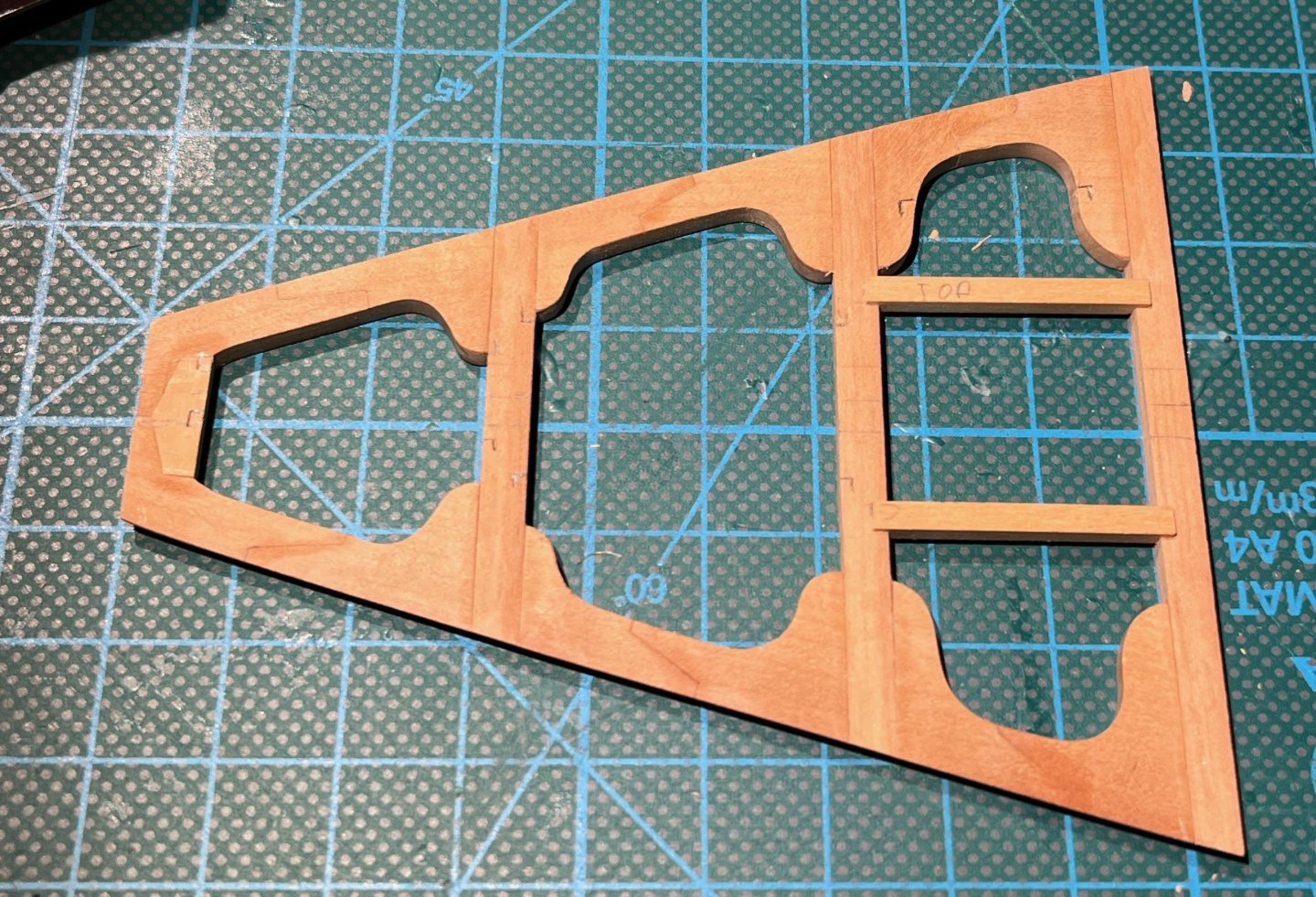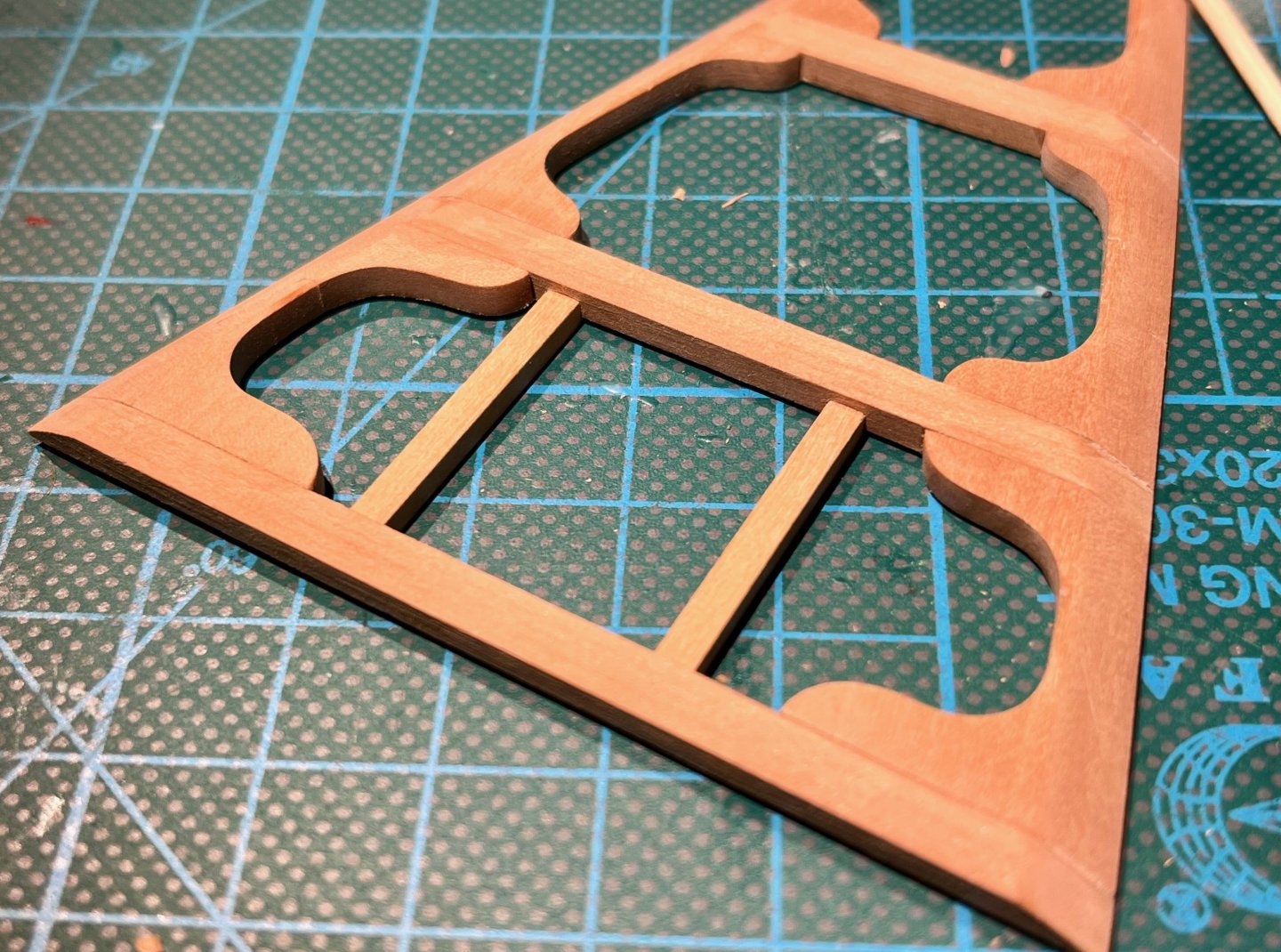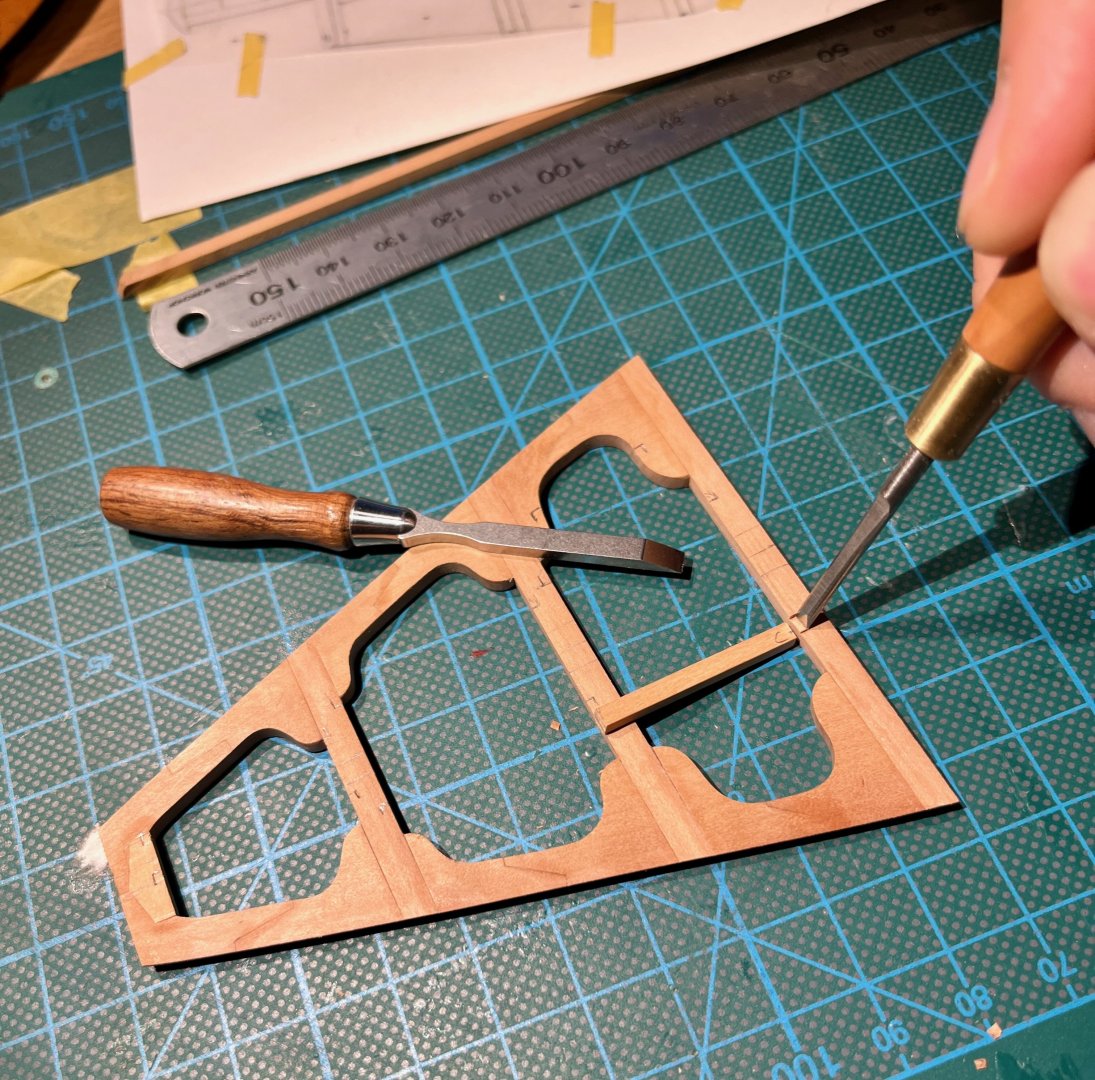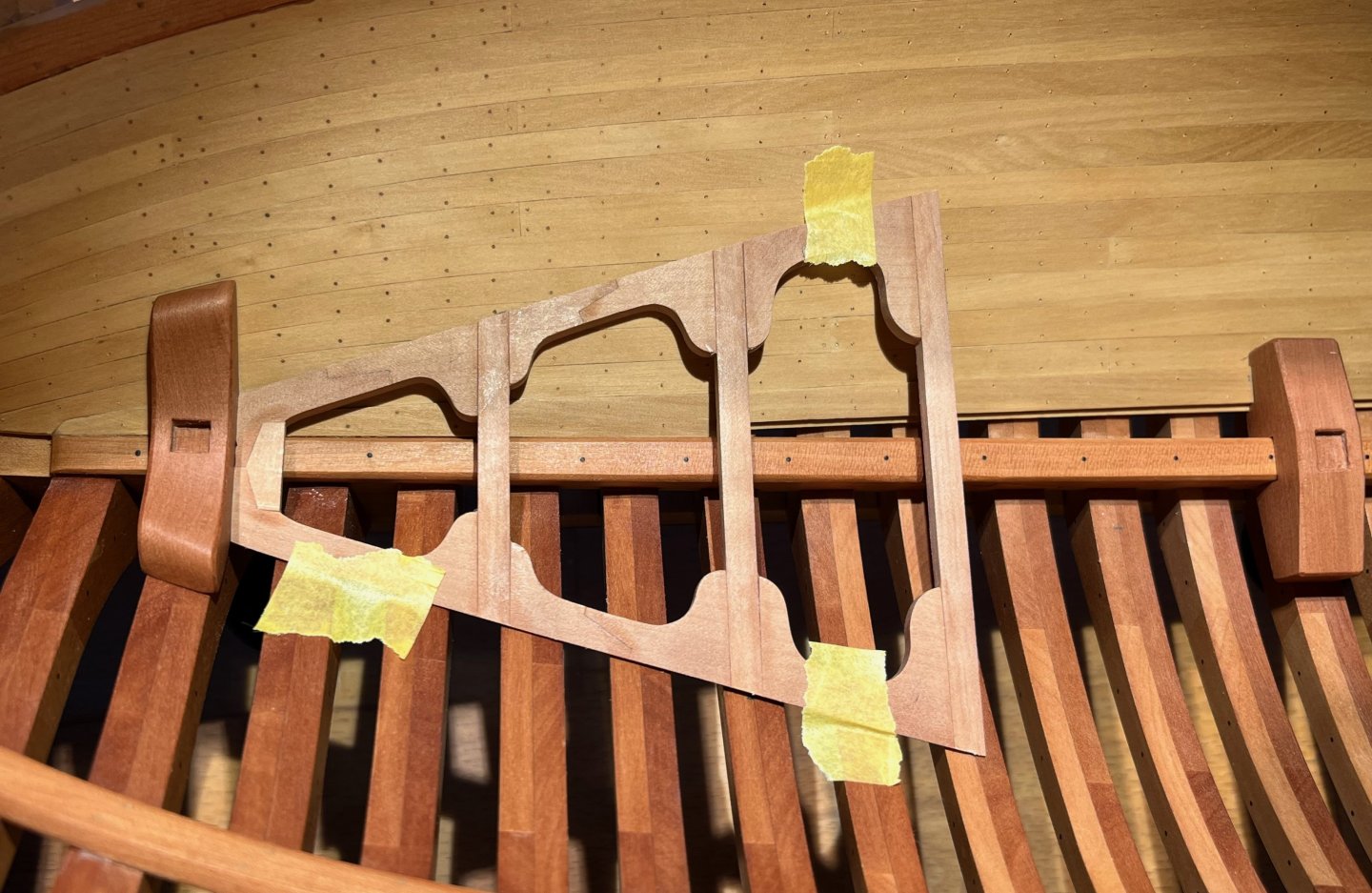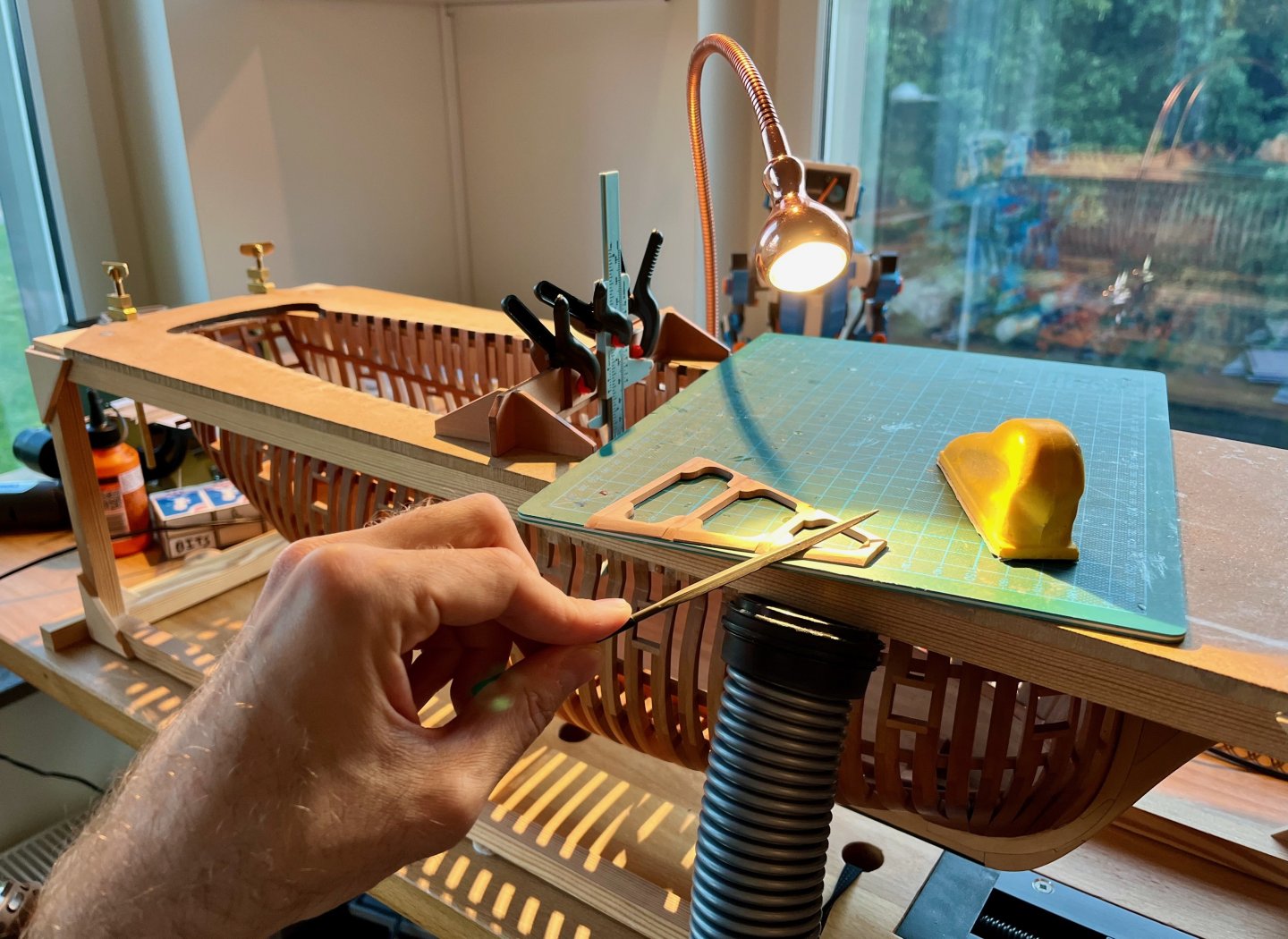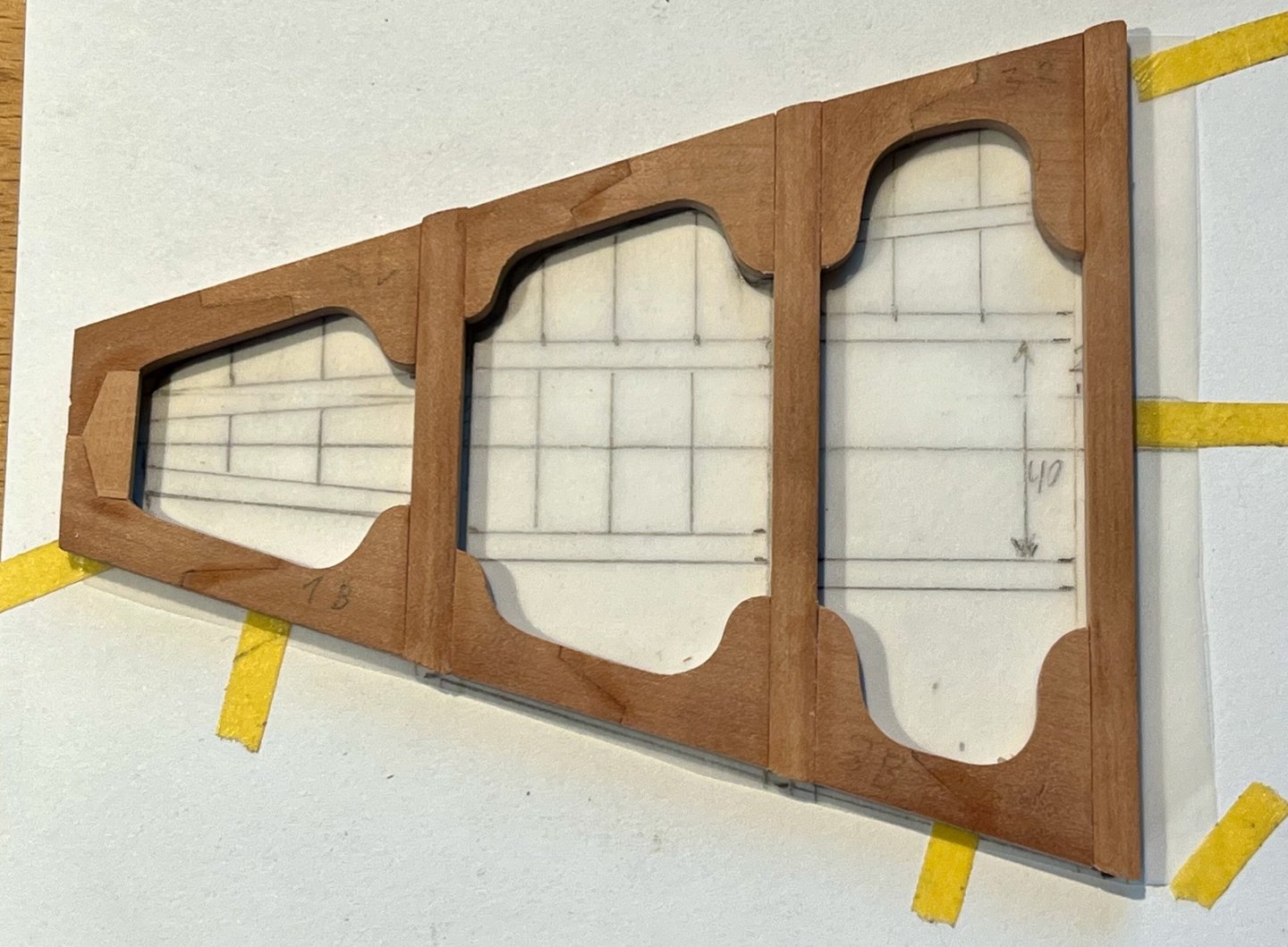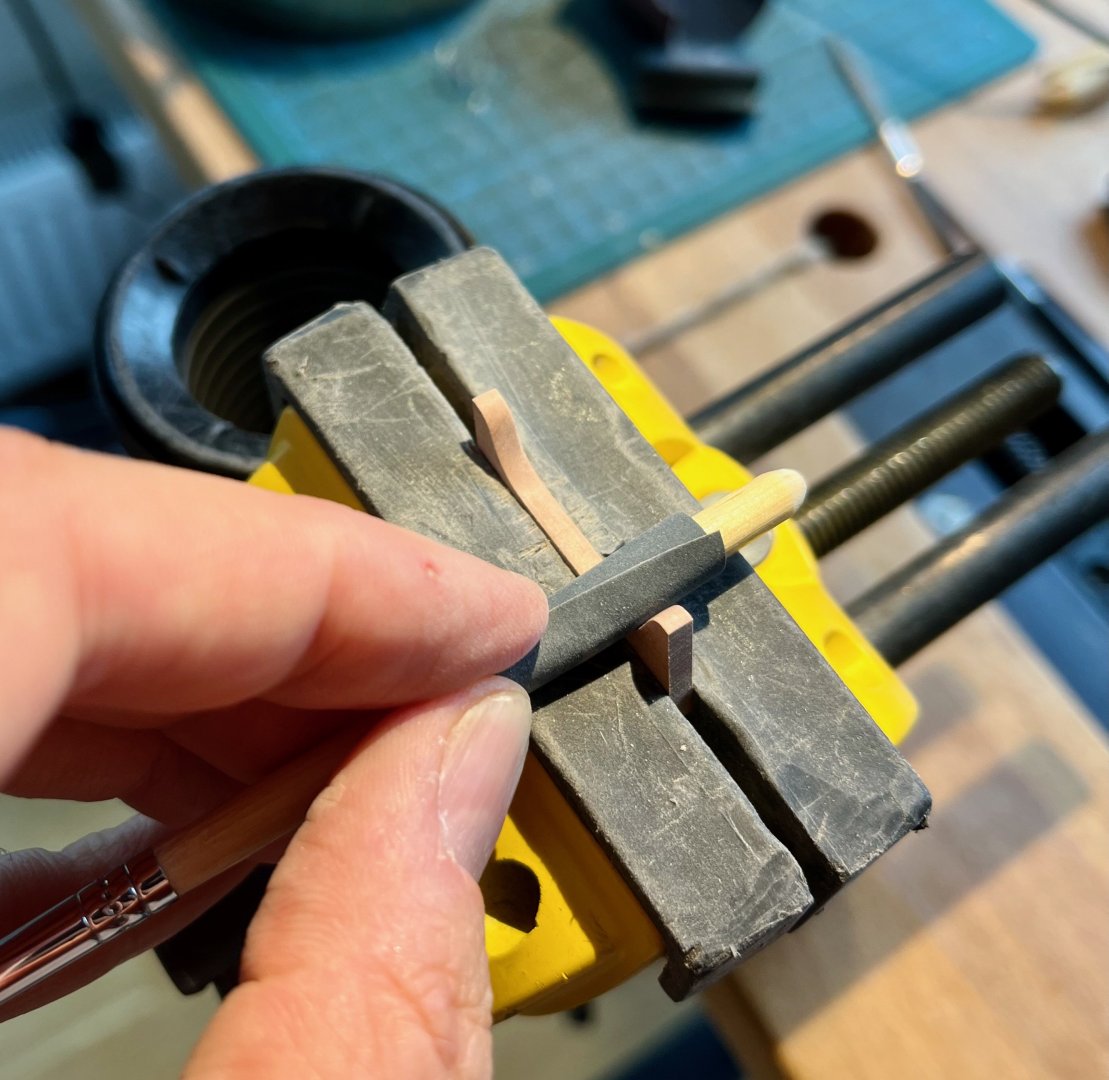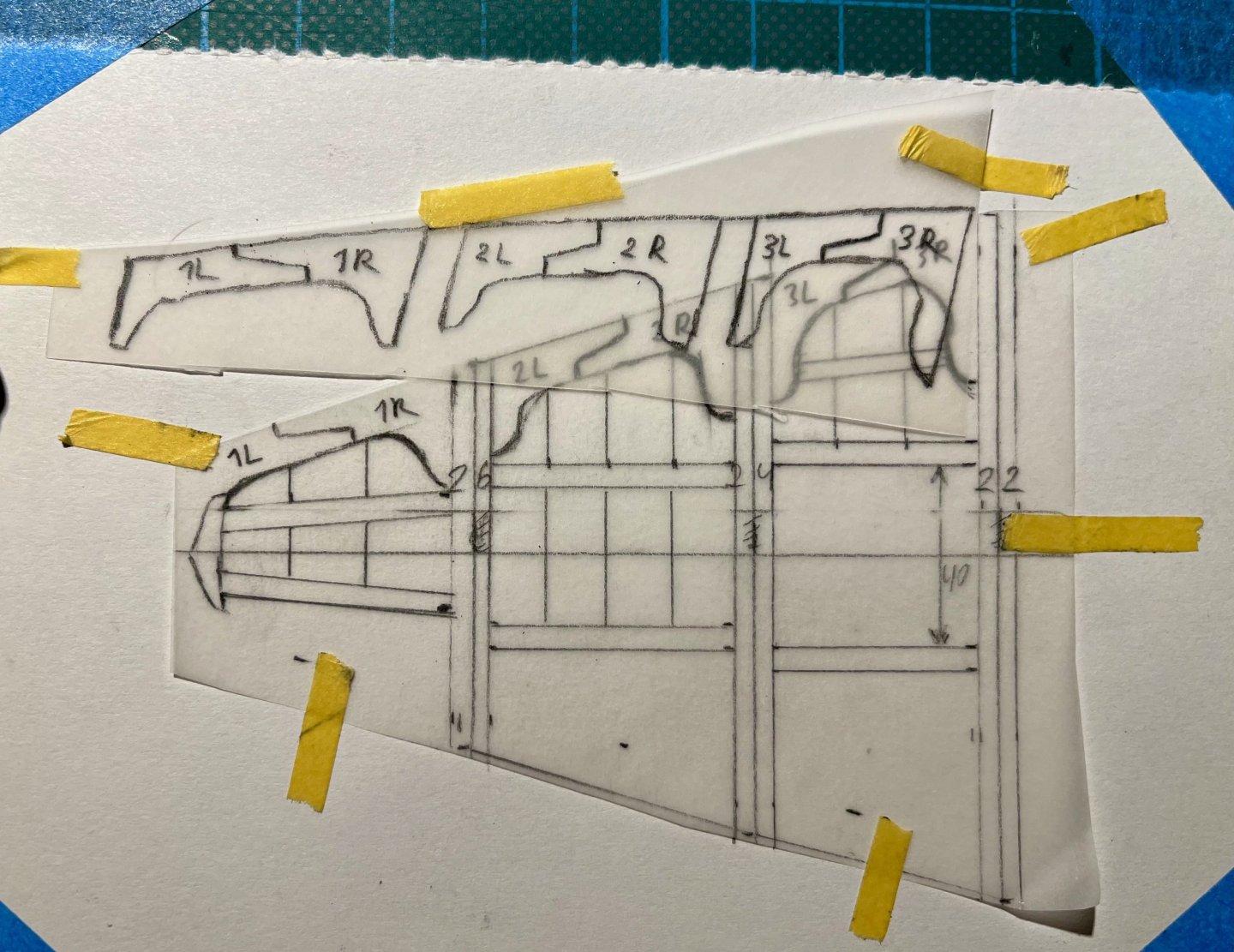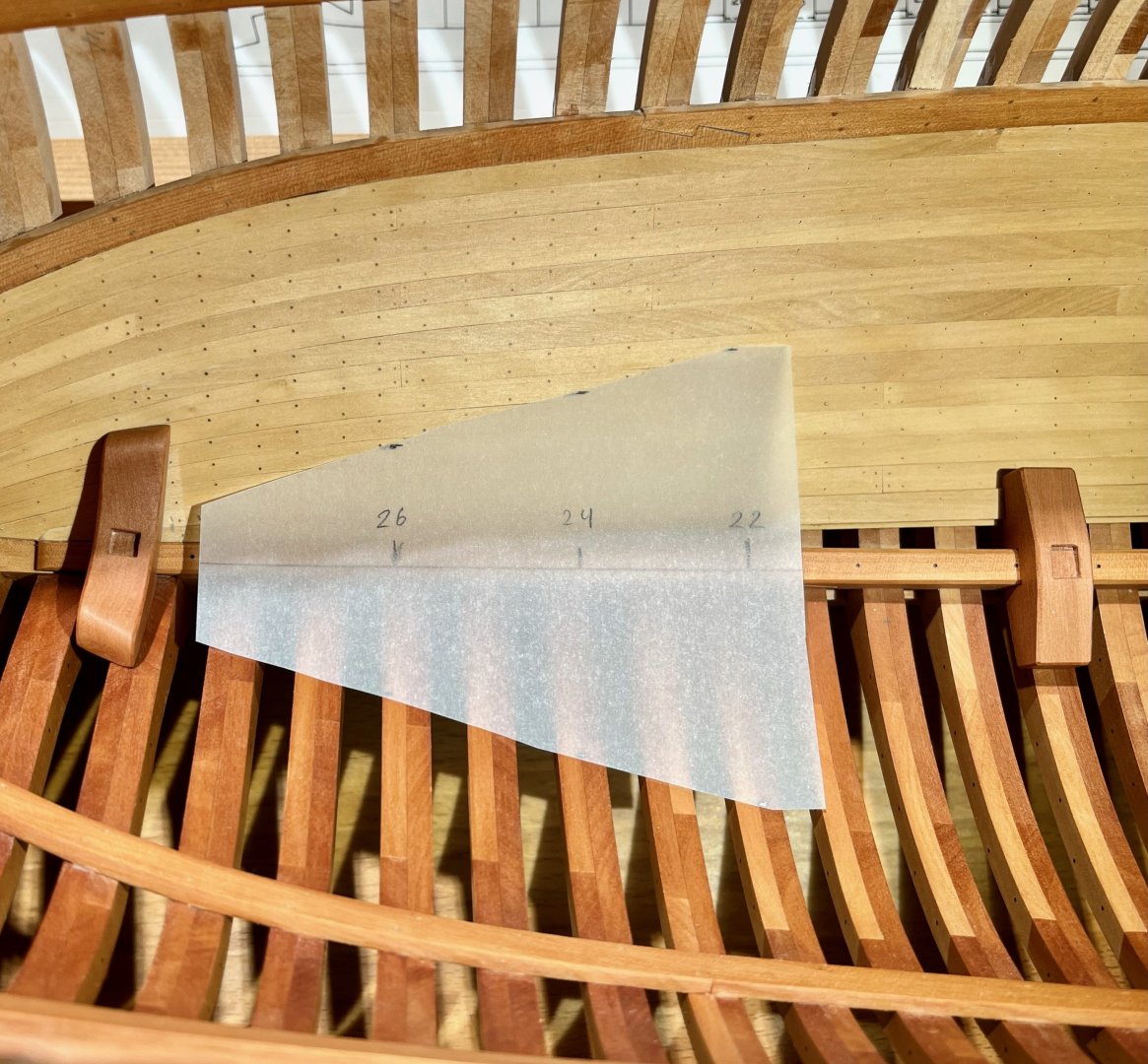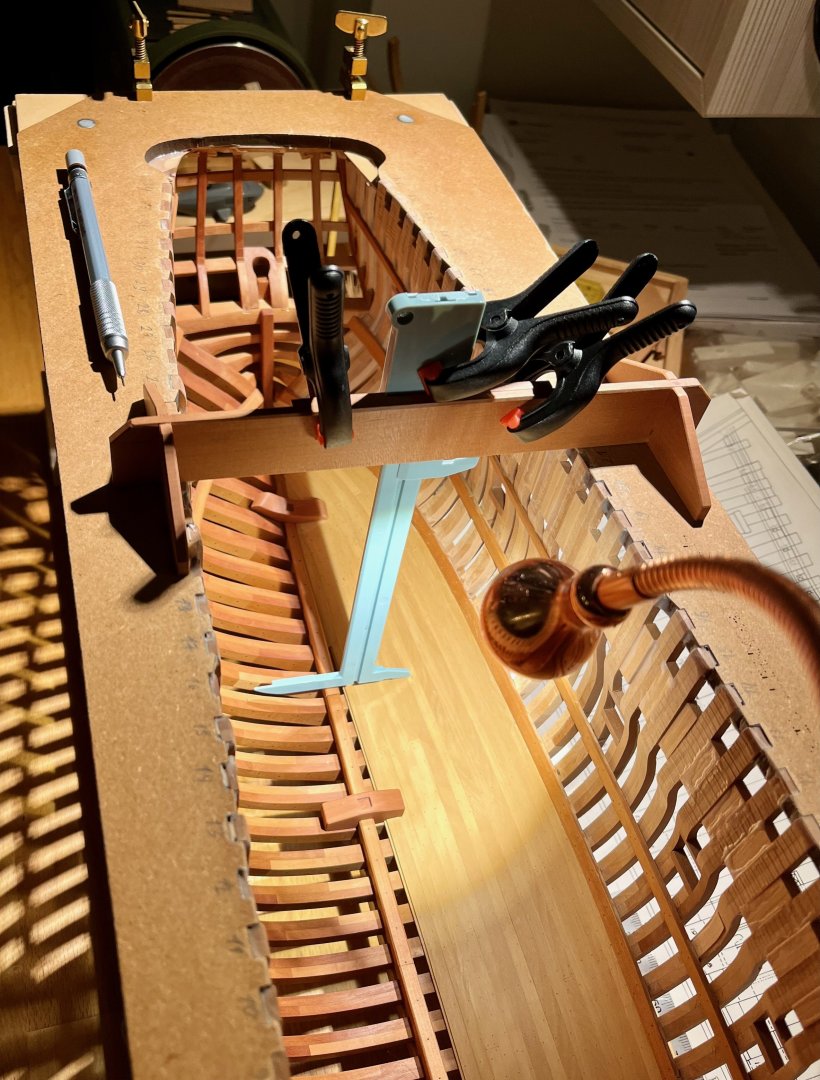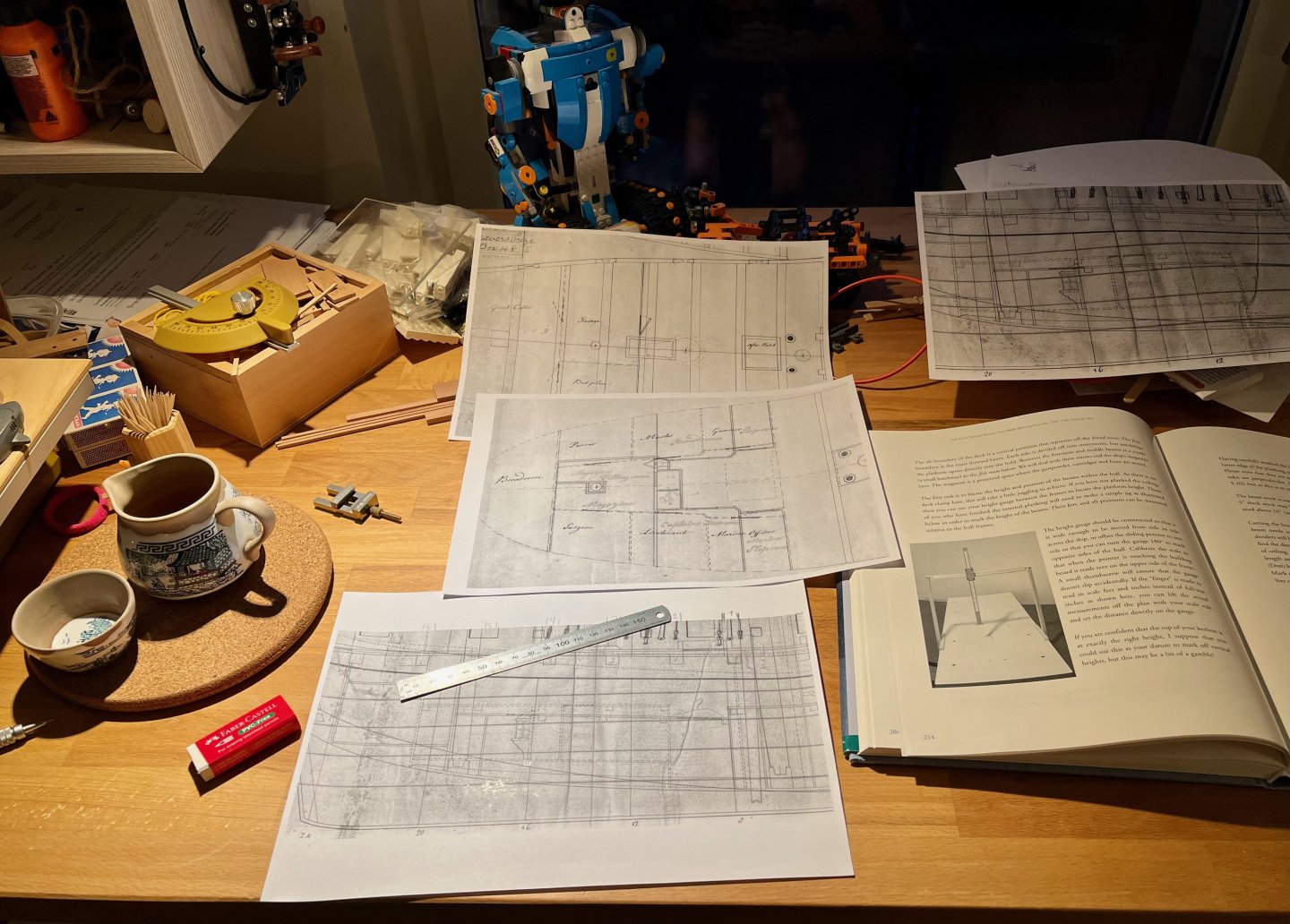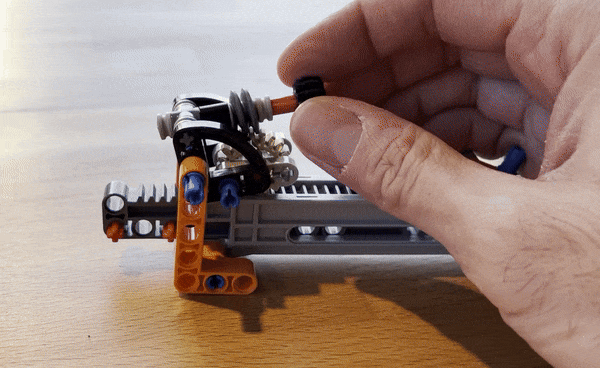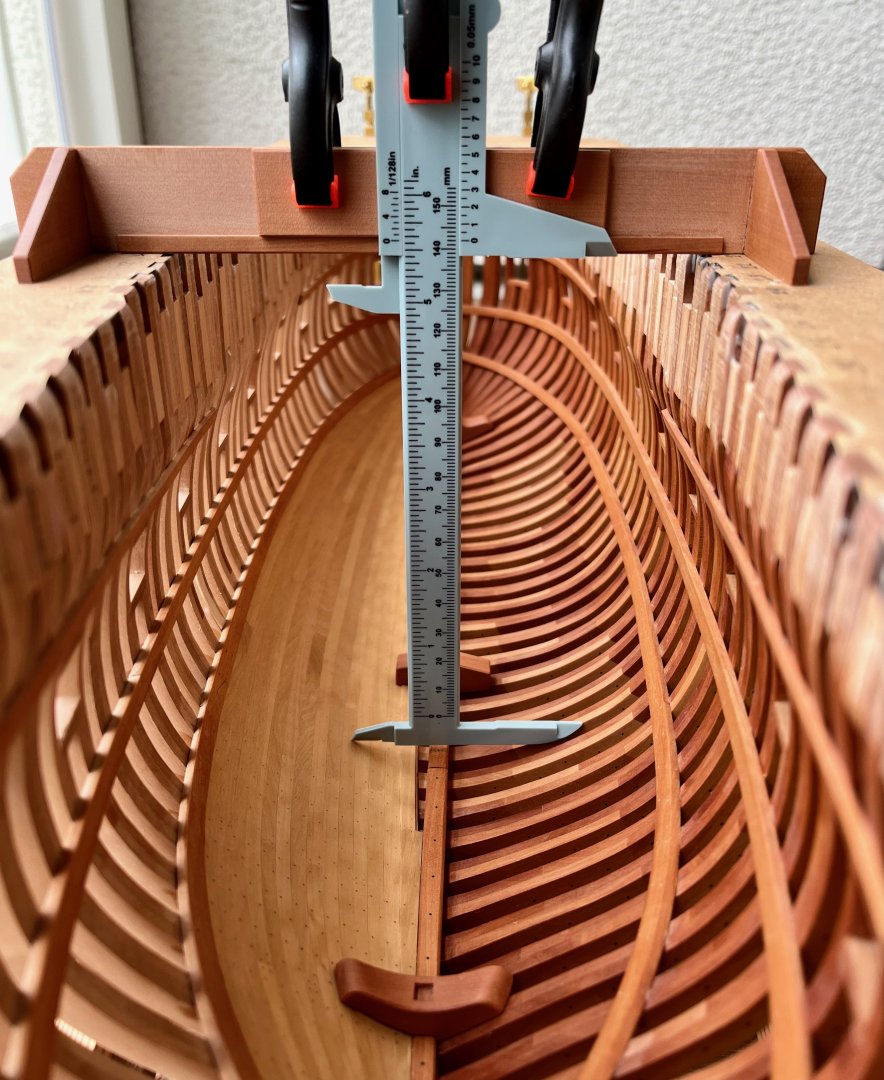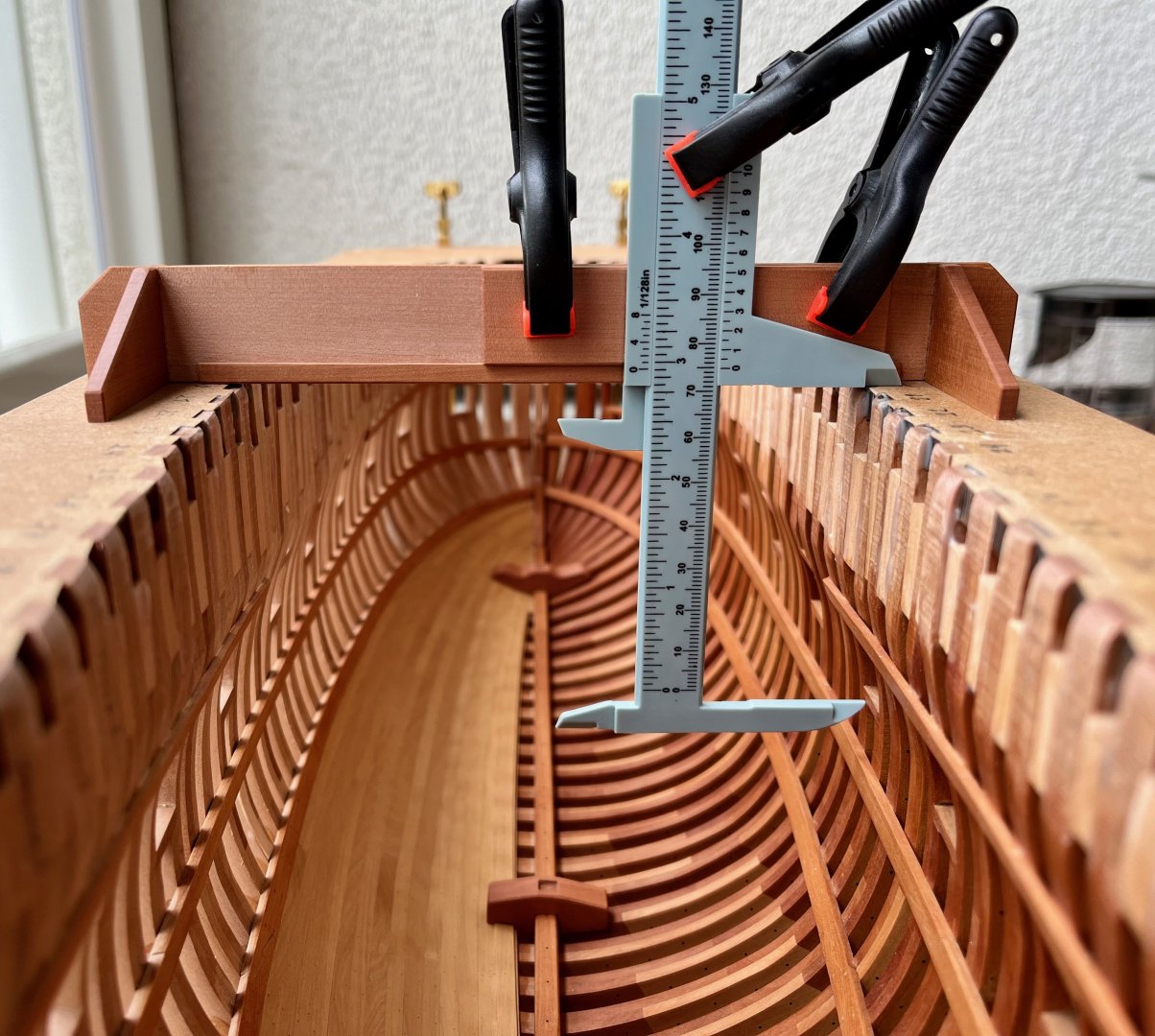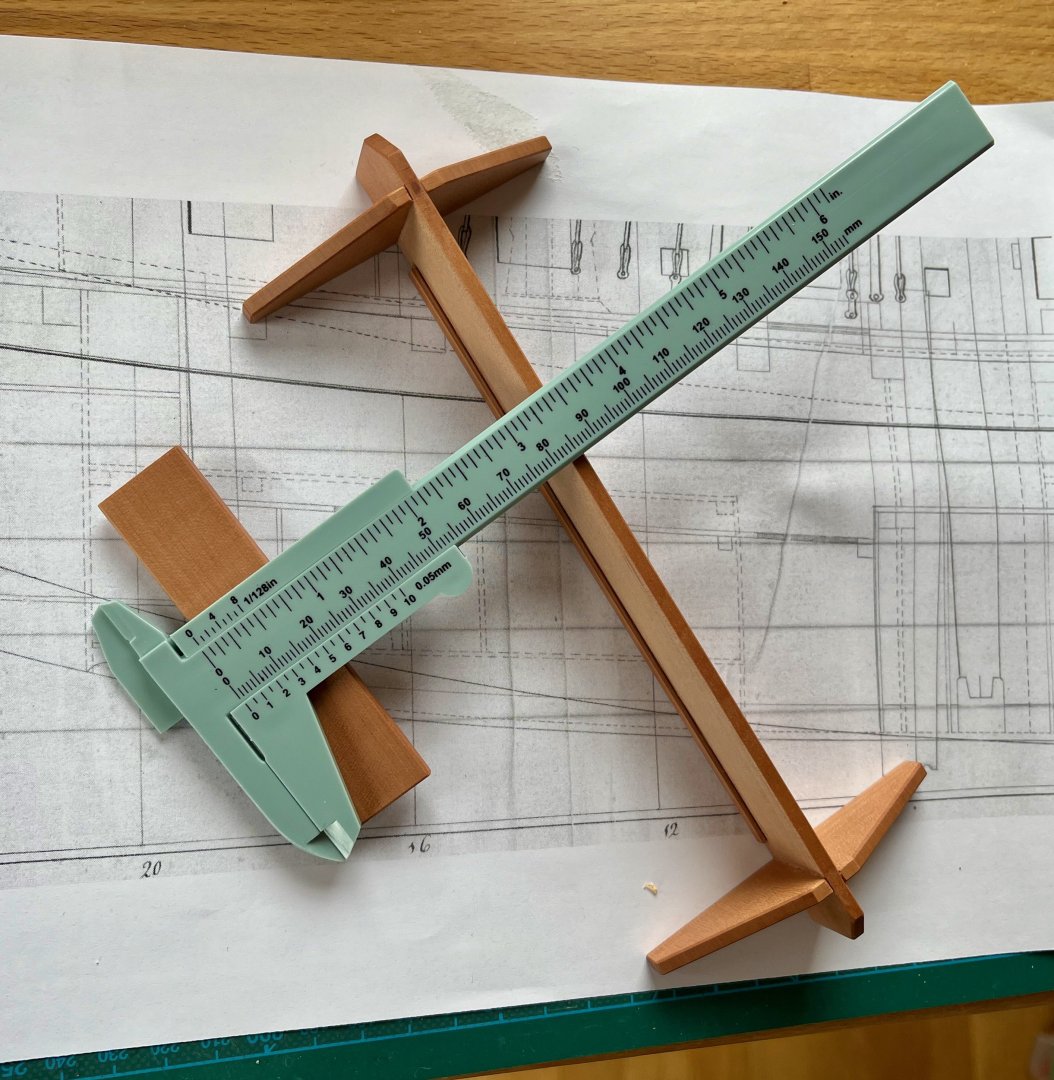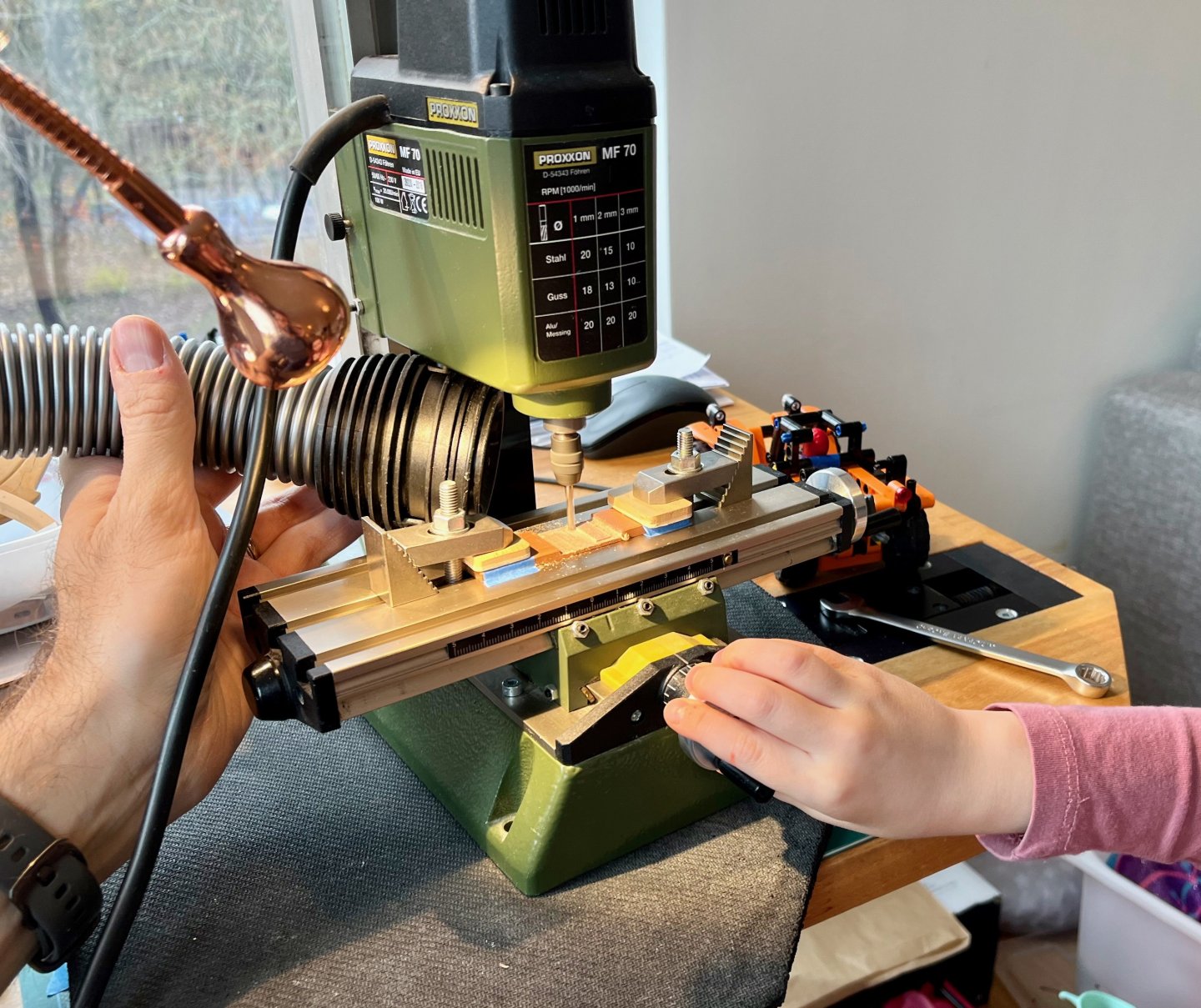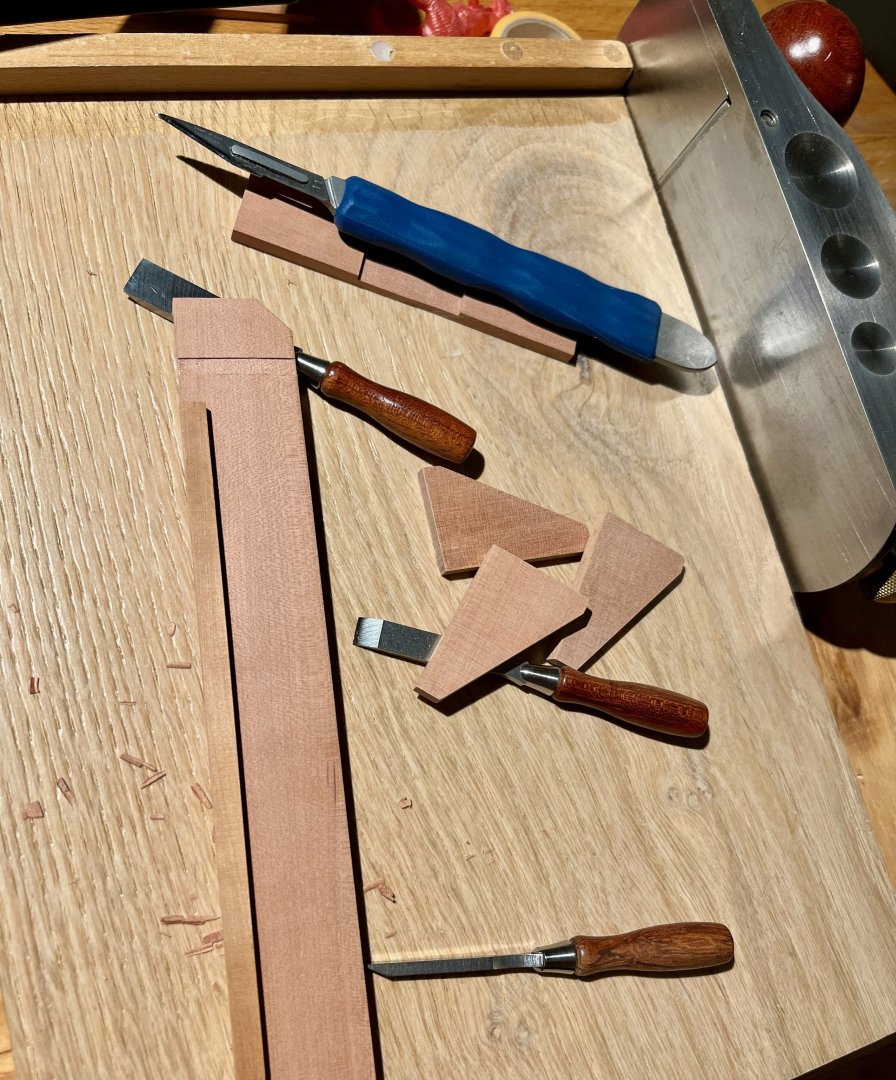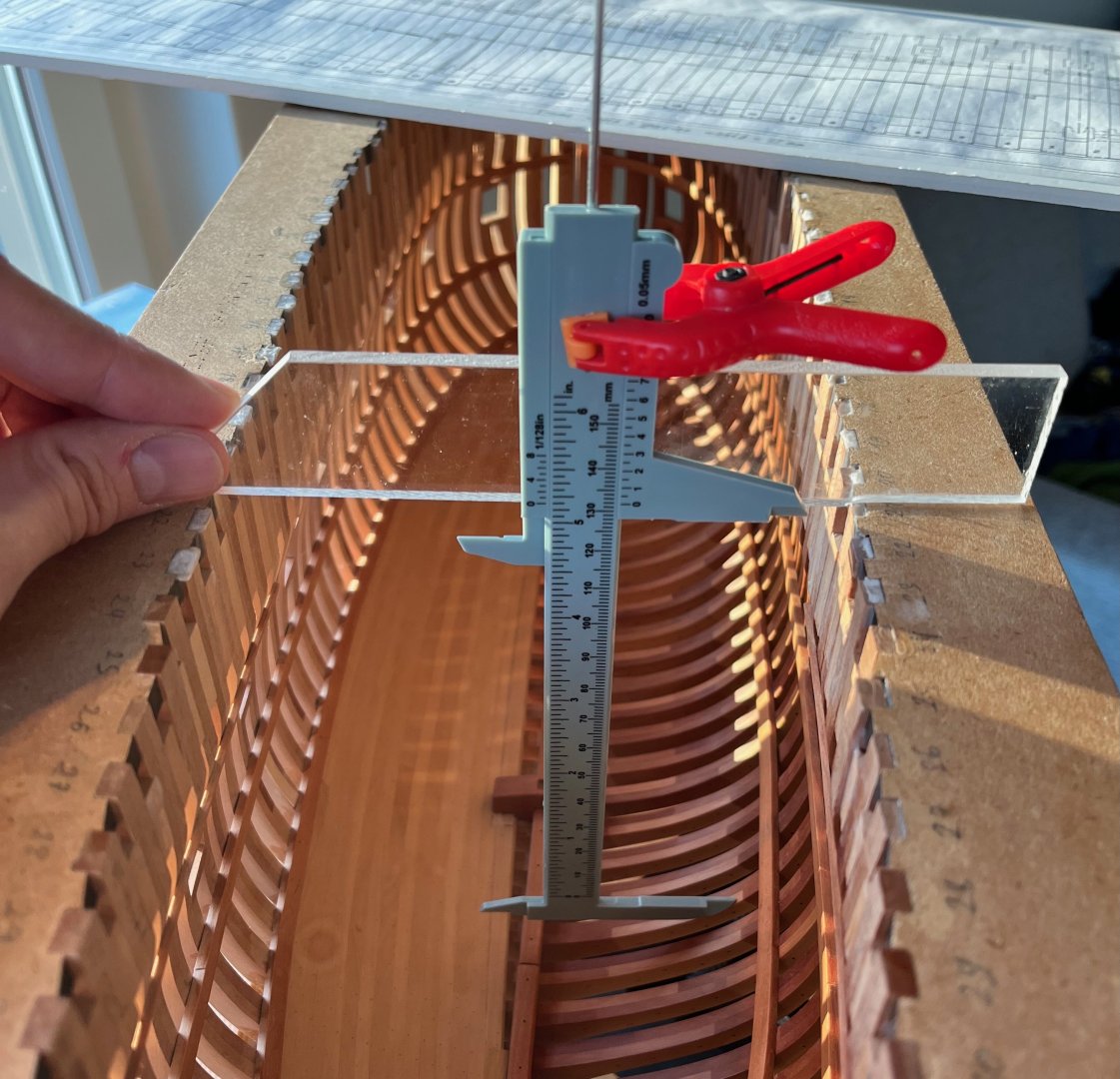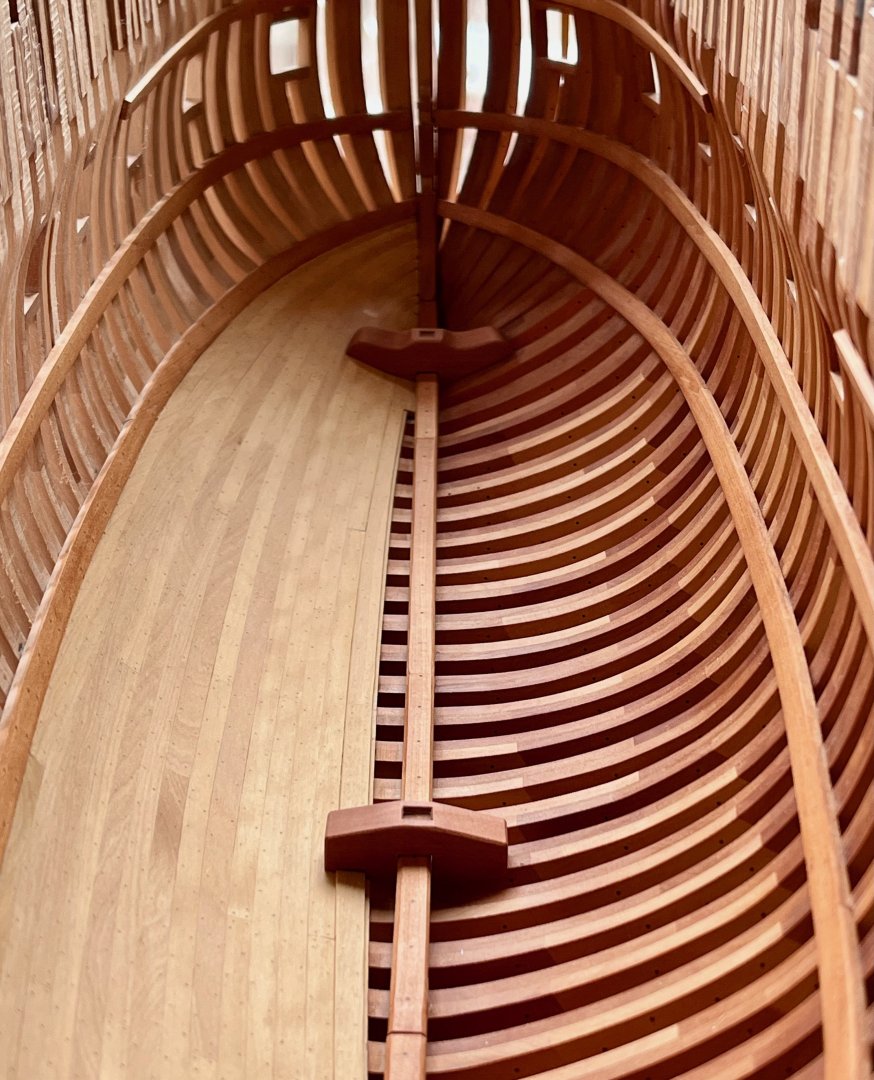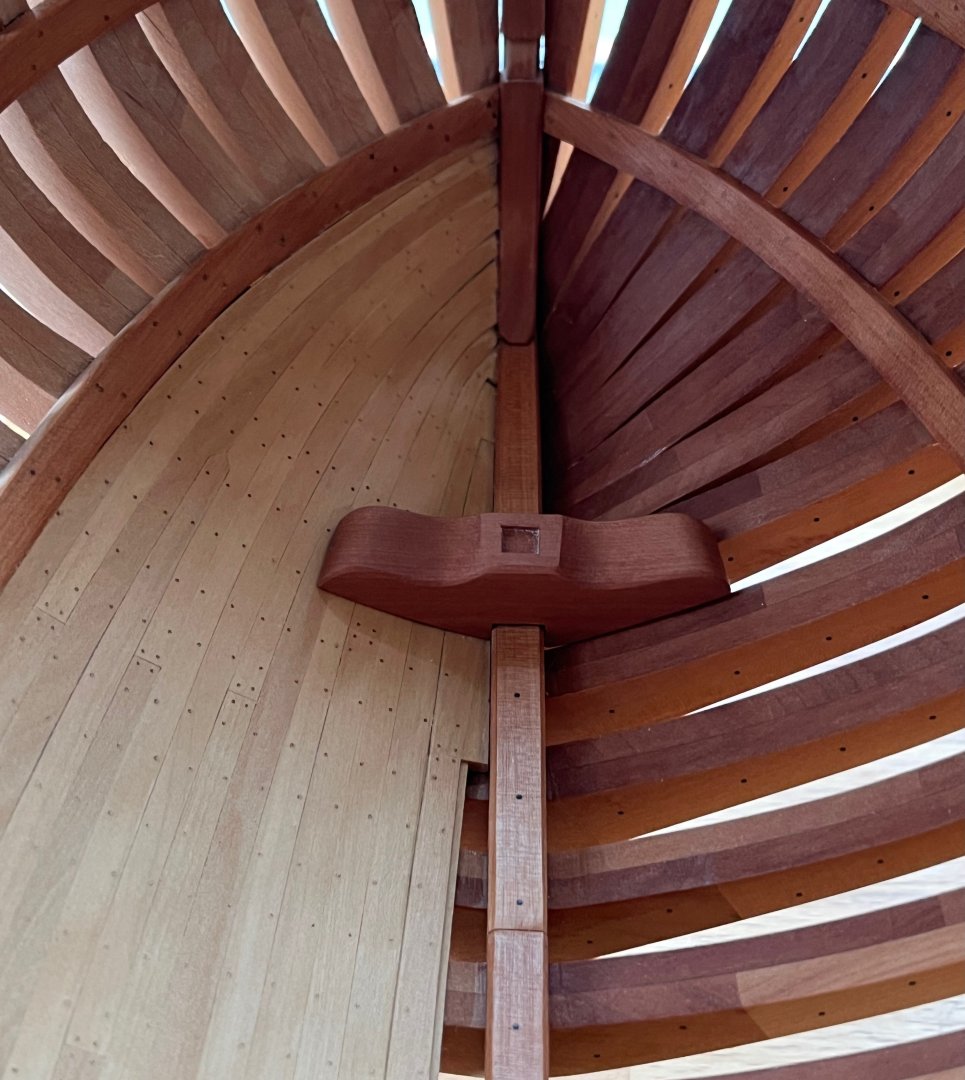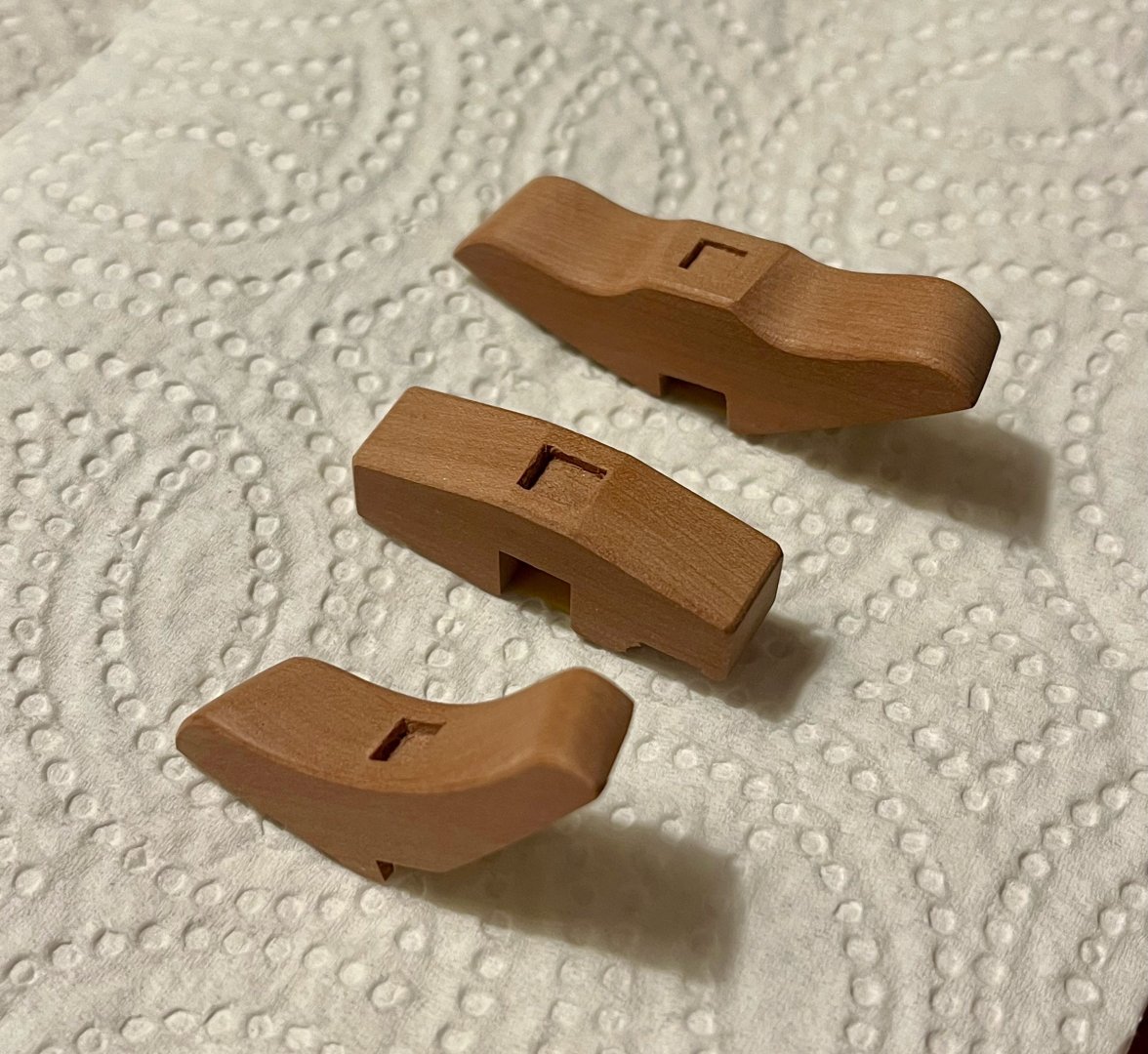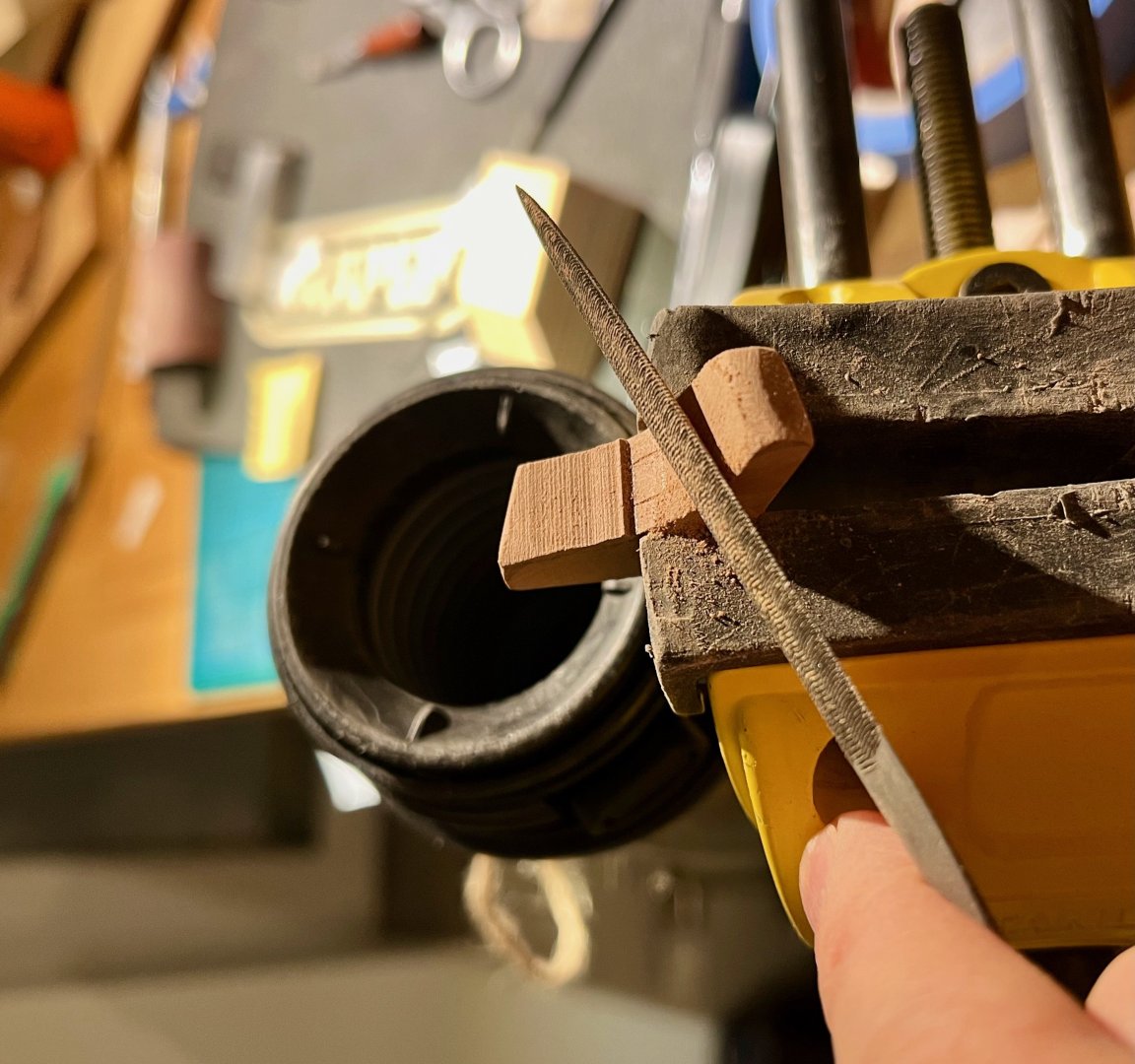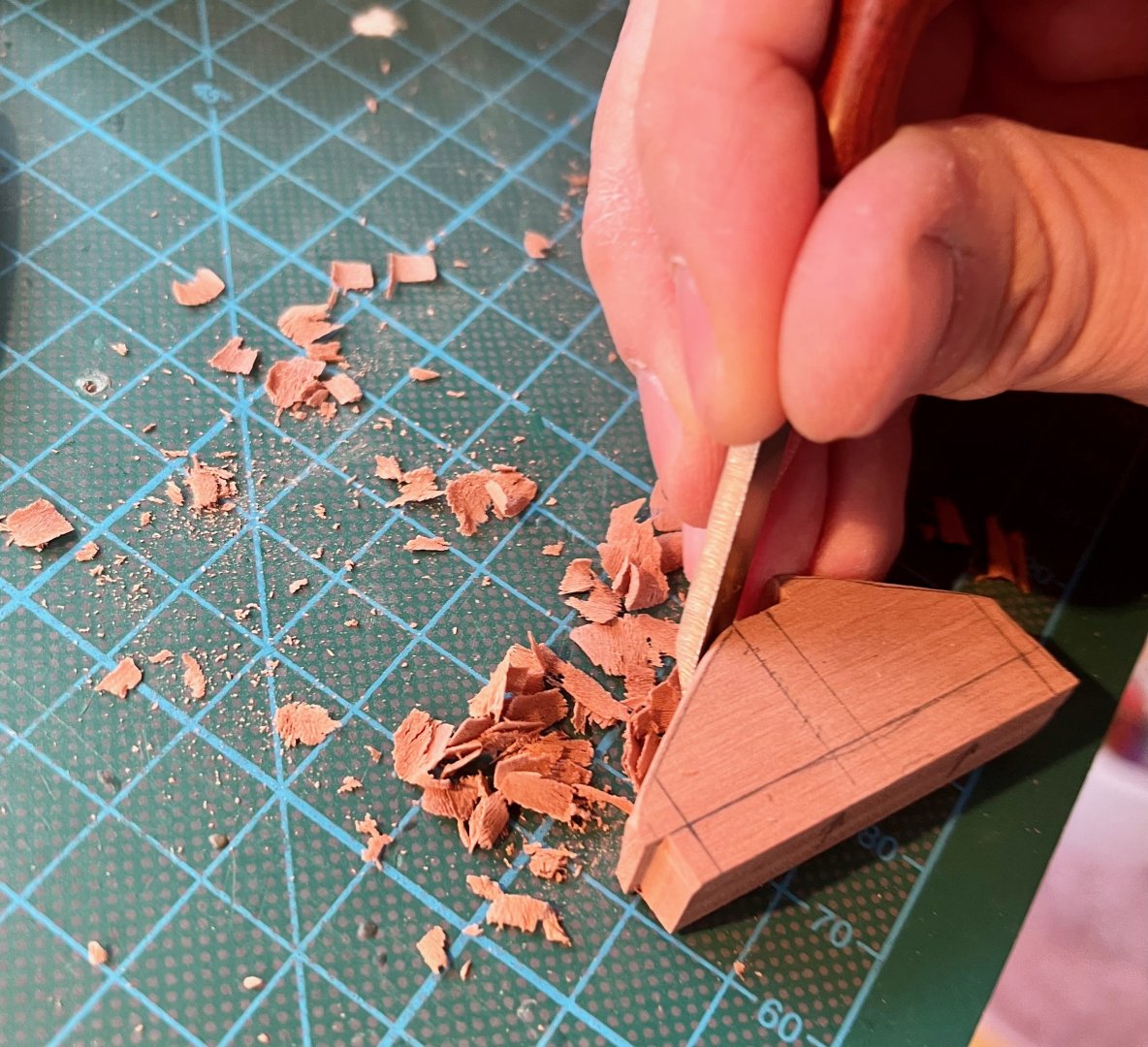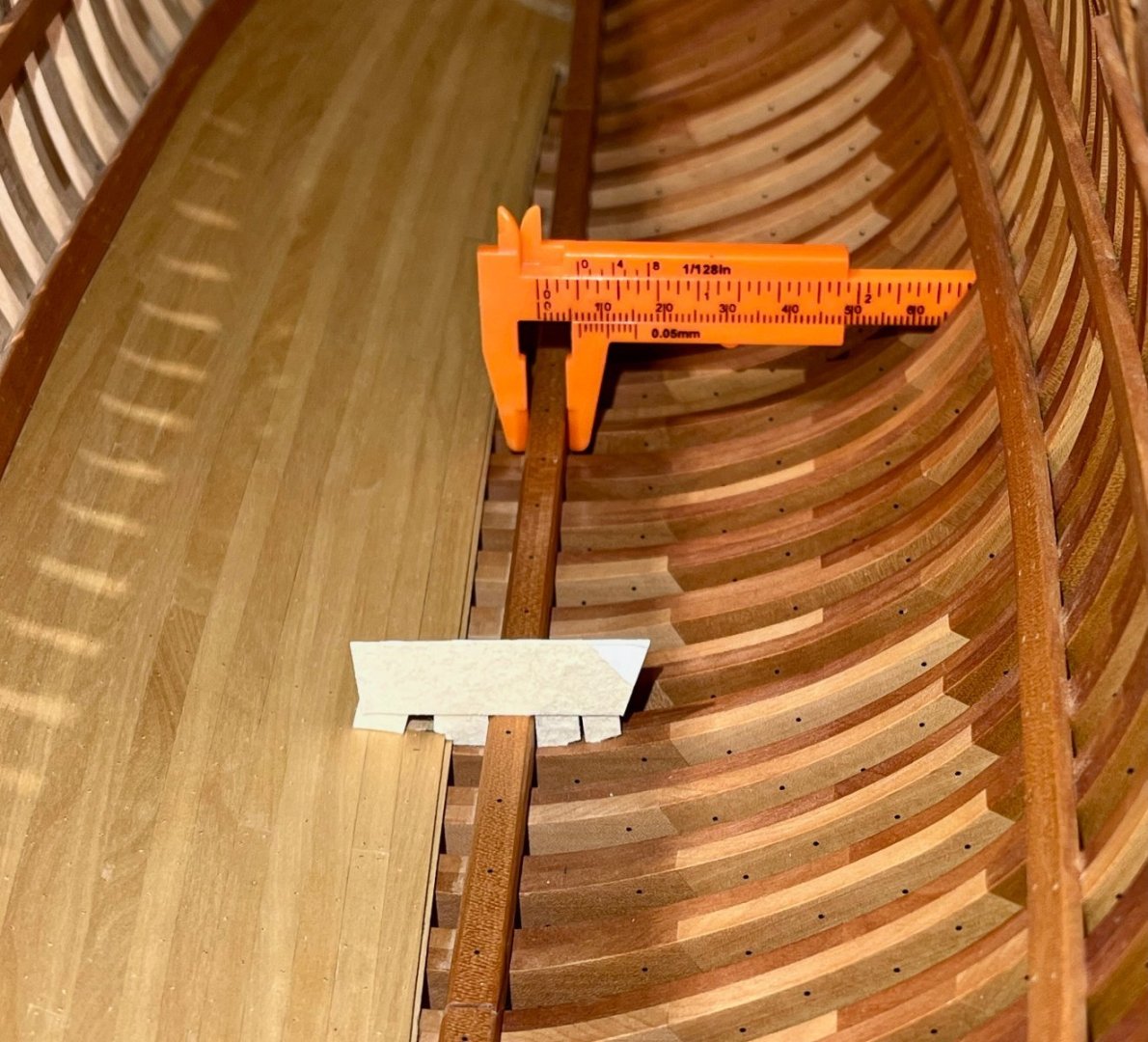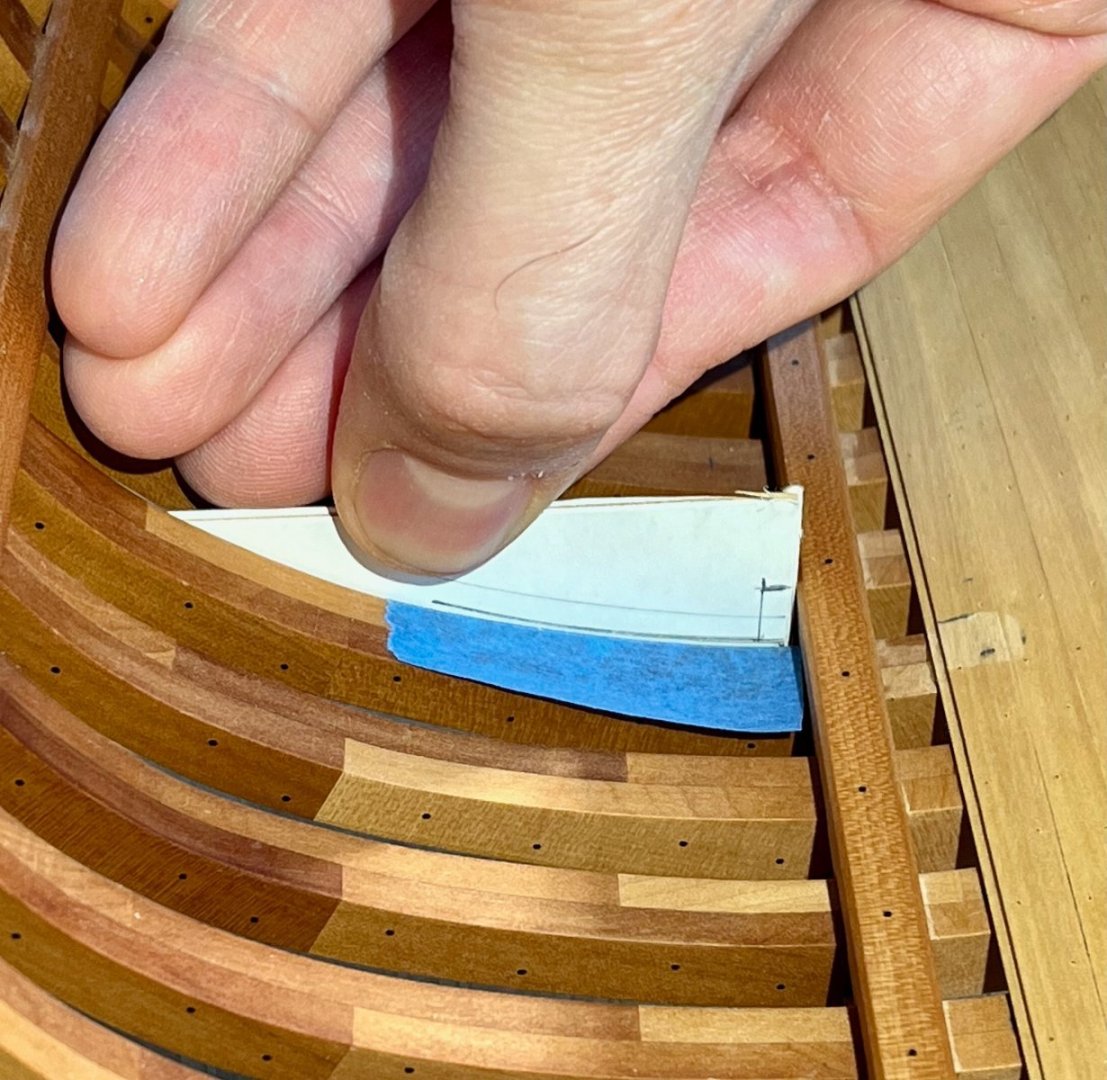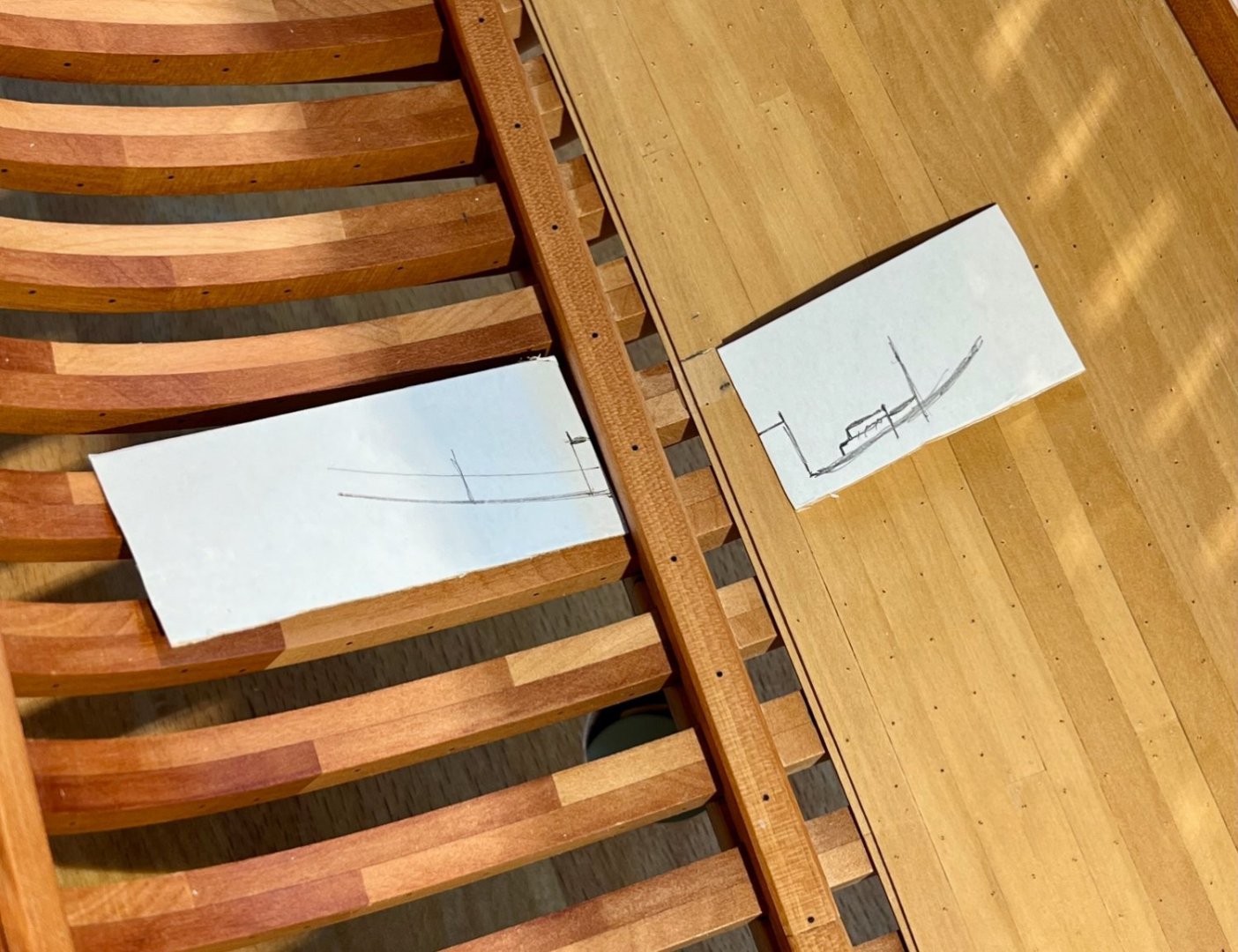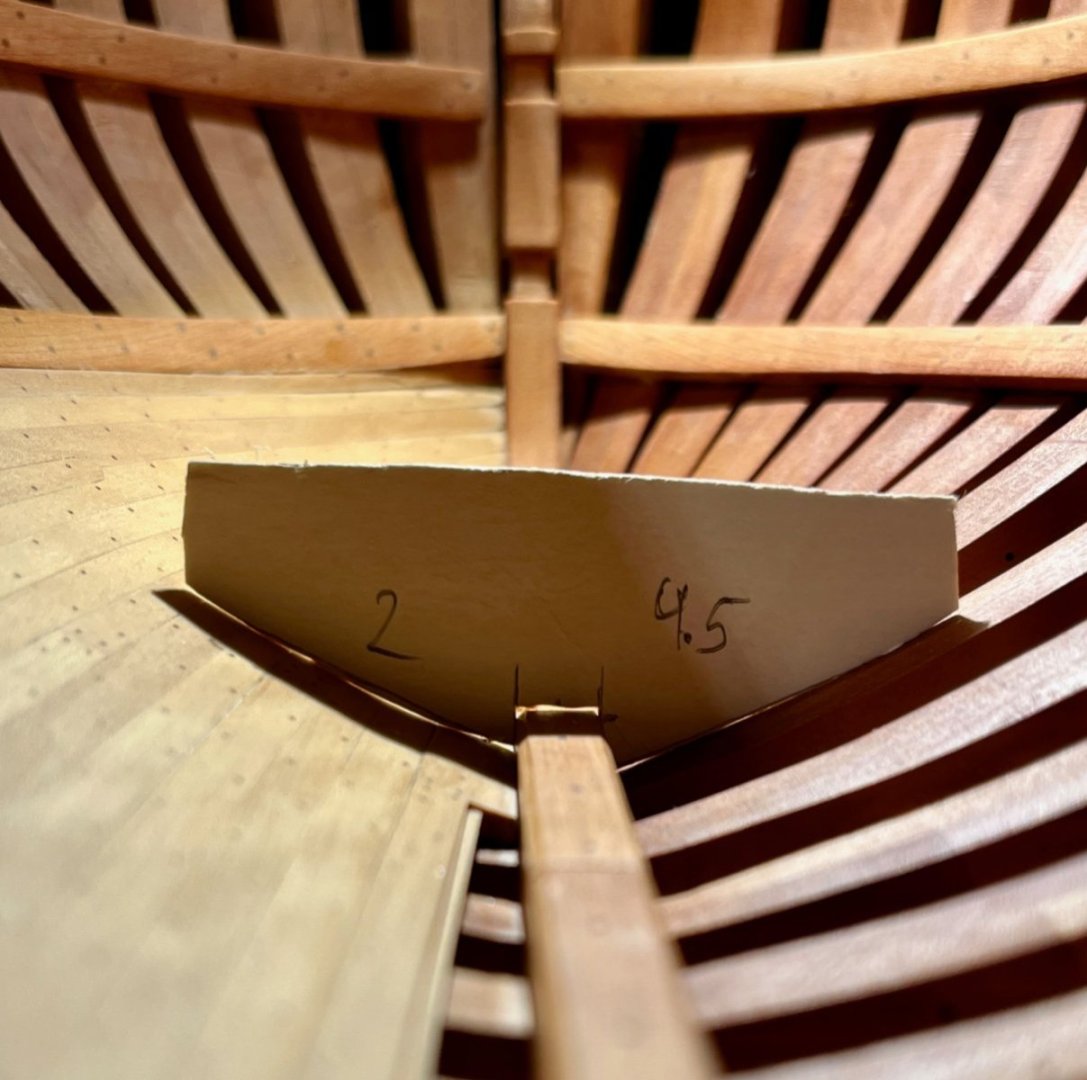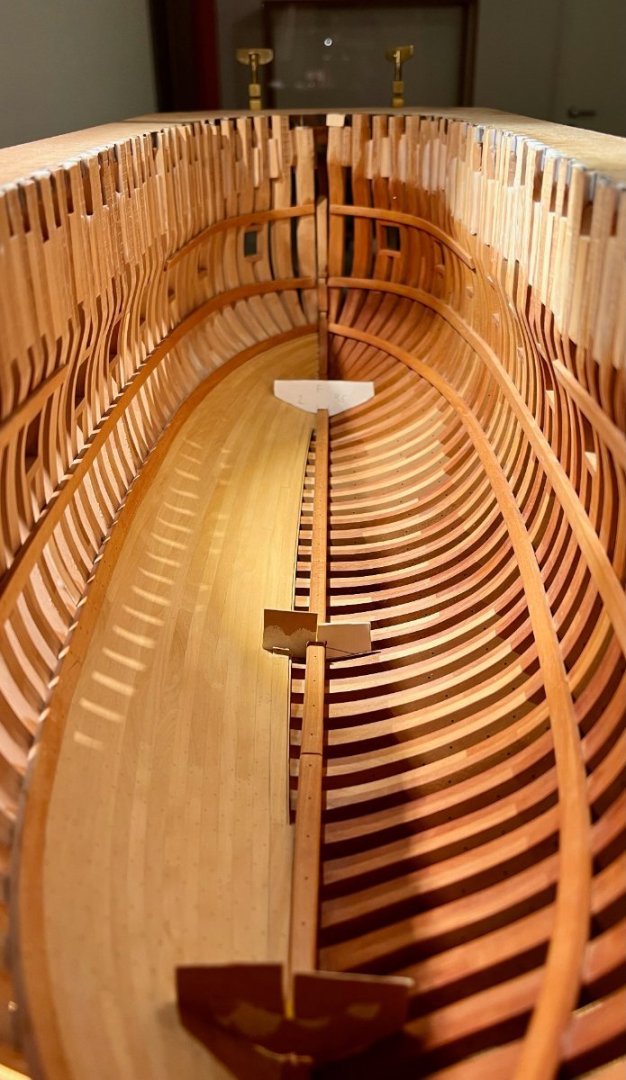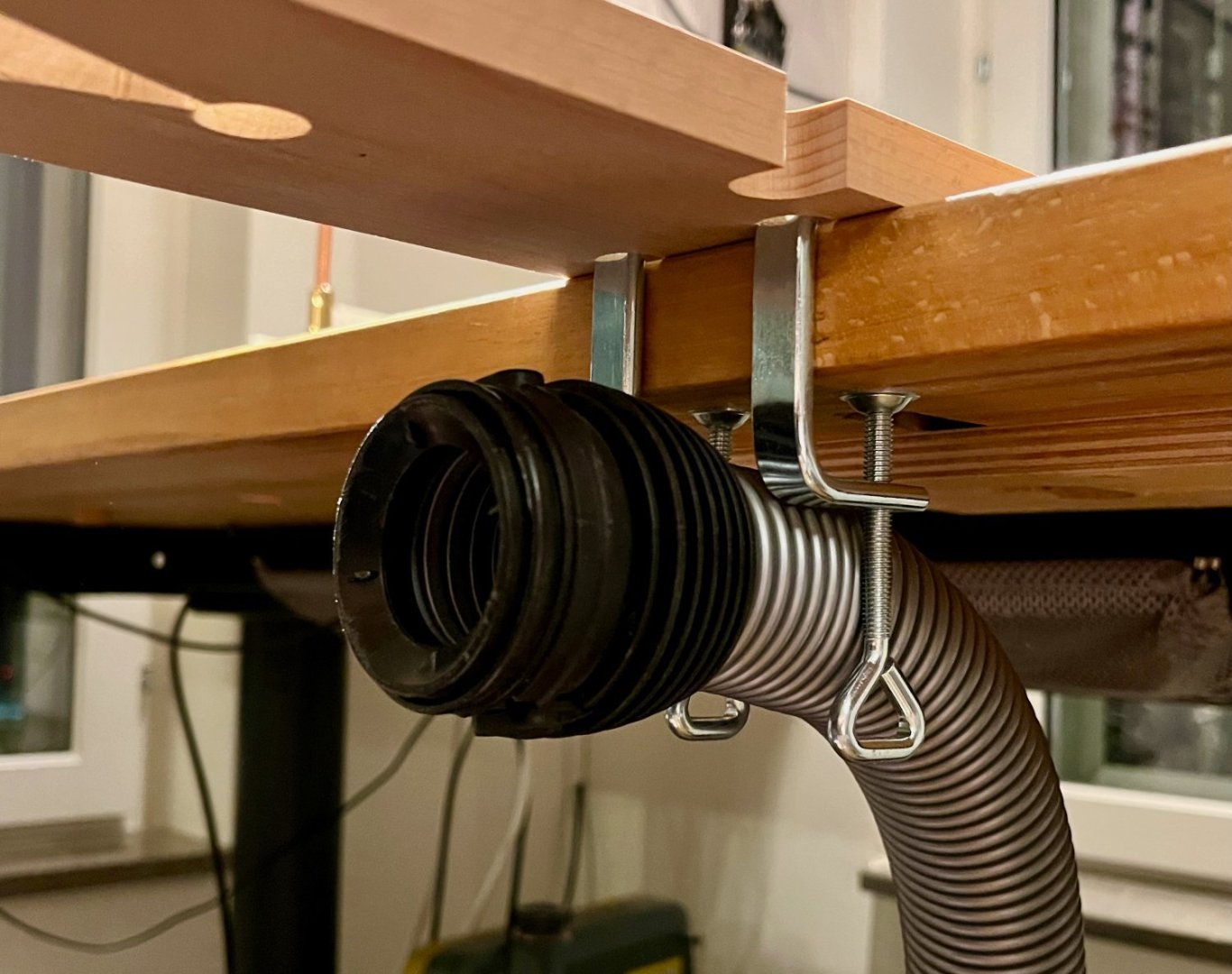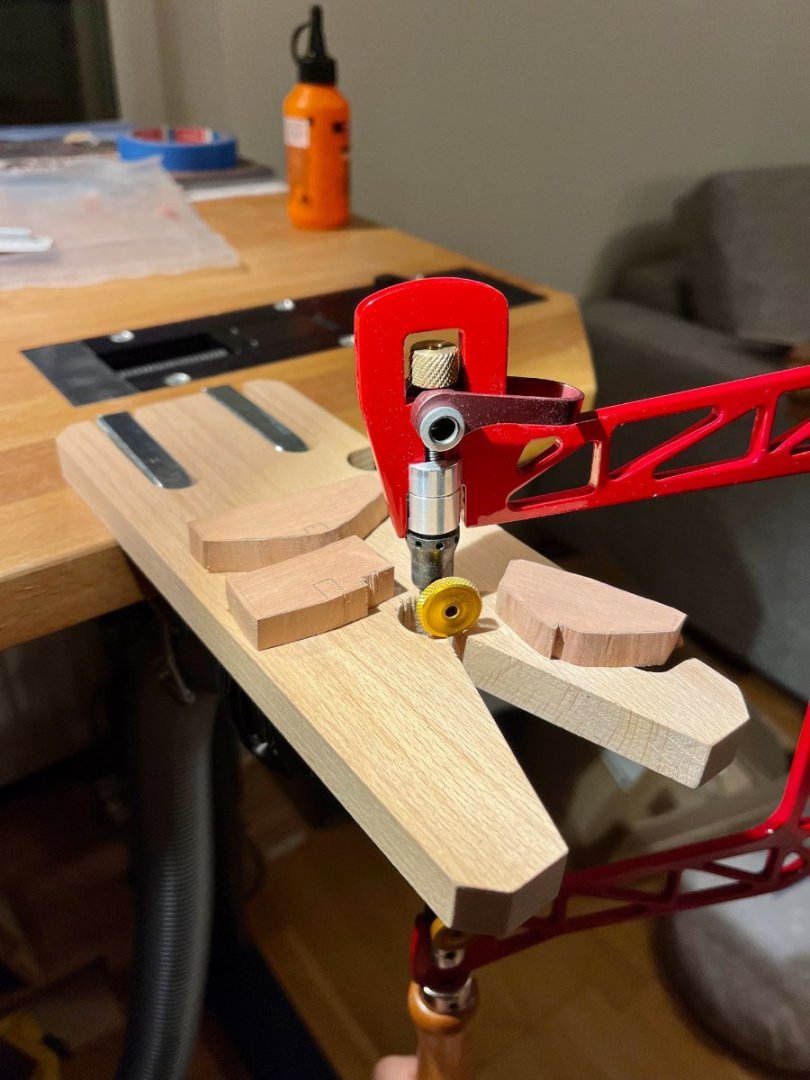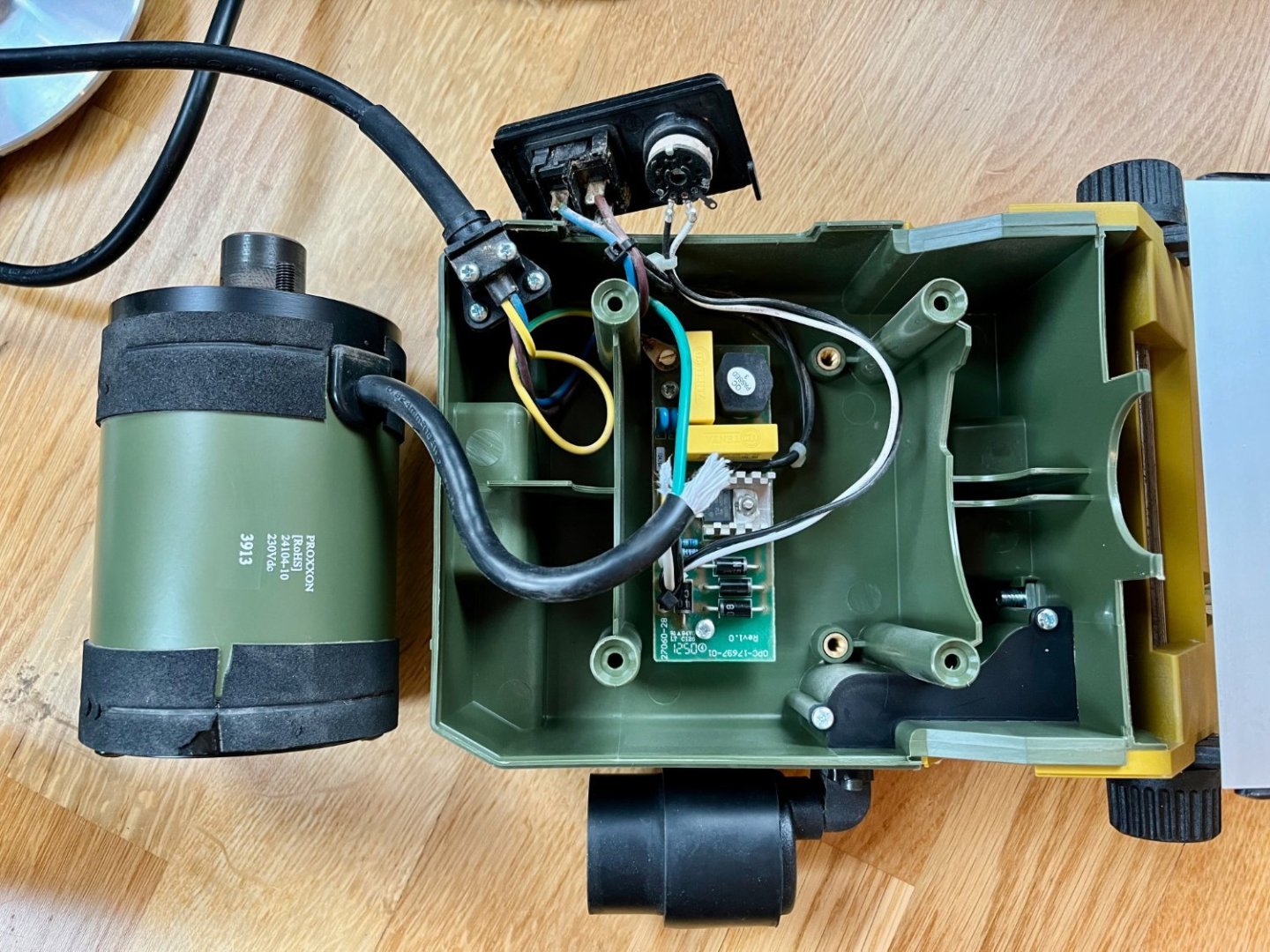-
Posts
1,557 -
Joined
-
Last visited
Content Type
Profiles
Forums
Gallery
Events
Everything posted by Mike Y
-
Next up was fitting the platform into the hull. Hahn jig makes a very nice stand for dust-free sanding and fitting, would come in handy When fitted into the hull - the platform looks quite off-center due to the one-sided planking. Carlings would be centered around the keel line, making them shifted from the platform center. Looks strange when taking a straight up photo, but it should be better once more layers are done, so it is viewed at an angle. I think it is a better alternative than adding spacers on the non-planked side or shaving off some meat from the knees on the planked side. The offset would get smaller the higher up you go, this platform is the deepest structure in the hold where the ceiling planking has a significant angle. Cutting notches for carlings was a blast! An incredible set of carving chisels came in handy, this is not even the smallest size! The smallest Veritas chisel for comparison. Incredible feeling when a piece perfectly fits into these notches when dry, nice and tight! Video 2024-07-29 22 01 07.mov
- 968 replies
-
- hahn
- oliver cromwell
-
(and 1 more)
Tagged with:
-
Was postponing the next big phase of the build - platforms & decks. It should be a very enjoyable part, one of the main reasons to start the fully framed model in a first place. But the learning curve is steep, primarily the planning part. Previously I relied on Hahn drawings to locate the parts, and the rest was rather repetitive. Now I need to sail uncharted waters - Hahn only provides locations of top deck beams and that's about it. So I relied on TFFM to understand the inner workings - these books are worth their weight in gold, I am immensely grateful to authors for simplifying a lot of research in an easy to understand form. And, of course, old Admiralty drawings from May 1778 done by George White. So I spent some evenings trying to wrap my head around and map the location and dimensions of the aft platform. Brain went into an overthinking mode and too many decisions should have been done too late in the evening. "What should I take as a reference point vertically? What about the horizontal reference? How to ensure a fair line? What method to pick to compensate for a lack of planking on one side? How to avoid a cumulative measurement error creep?" Finally the markup was done And a transparent template was born Transfer paper allows to copy the shape easily to cut off the wood patterns, but of course it leads to a creeping inaccuracy. Shaping 12 symmetrical parts that form 6 knees was not easy, but at least it did not require any thinking - just a pure relaxing process of small wood parts fabrication. Was missing a nano-sized flush trim router to make an exact mirror copy of each part Ideal usecase for CNC! Though where is the fun in that... Even forgot to take any pictures, the only one is the final edge polishing. The final assembly was tricky. I was planning to fine tune the knee angles, but trying to assemble a trapezoid when all its sides are sliding around is a very annoying process. If only I could somehow clamp all these pieces 🙄 Oh, wait, the past me thought about this and made some clamps. Six years ago. 😳 How very nice of me! Time to dust them off and use them first time for their intended purpose! They worked excellently, providing a gentle clamping force to get all pieces under control. Still took a while to fine tune the angles (adjusting one angle immediately affects the rest, what a mess). Here is the assembled platform, just need to fit it to the hull, add carlings and ledges and sand everything nice and smooth. Before adding ledges one is supposed to make sure they do not interfere with the lower deck pillars, but it's too much effort for now (requiting to mark the locations of all lower deck beams), creating a risk for another half-a-year modelling block. Will sort that out afterwards, moving the beams a little bit and even notching some ledges into the pillars. After all, the ship I am modelling is not famous for the build quality. The whole story around it smells "Friday night shift, shoddy engineering", so a few internal structural members overlapping each other are rather on brand Glad it would be hidden deep in the hold, a practice piece that still gets to be on the model Also I saw a number of build logs using pins to dry fit in place, but that implies drilling a tiny hole in the part. Do you just leave a hole there? Or plug the hole with glue and sawdust and do one more round of sanding before the final glue-up? Would be very happy to hear advices, suggestions and ideas to improve that process. I made it work, but surely it can be made easier and faster (and, frankly, more accurate).
- 968 replies
-
- hahn
- oliver cromwell
-
(and 1 more)
Tagged with:
-
If you are short on space - then yes, absolutely: https://www.proxxon.com/en/micromot/27110.php It is the smallest mill available in a reasonable price range (excluding aliexpress drill-mill junk combos), which is both good and bad. The working area is quite small, but enough for shipmodeling needs. It is hard to upgrade and attempts to machine anything harder than brass on that mill are rather questionable. But it is a great way to start and is fairly cheap in comparison. Make sure to get the "precision vice PM40", the cutters and basic workholding clamps should be already included. If you have a workshop - then your choice is much wider, there are a lot of medium sized "mini mills", but all of them are too big and heavy to be casually pulled up on your work table, they require a more permanent position in your shop. Proxxon, on the other hand, takes less space than some smoothie blenders in the kitchen
- 968 replies
-
- hahn
- oliver cromwell
-
(and 1 more)
Tagged with:
-
Thanks Rik, so glad that you find it useful! For the mill - the basics are very intuitive, no book or youtube guide required if you work with wood on our level. Feeds and speeds pretty much do not matter for the small wood pieces that we work with, common sense is enough (keep the fingers away from the cutter, do not try to cut 2cm deep in one go, listen for the sound that the cutter makes and slow down if it sounds rough). The cost of a mistake is also relatively low, worst case scenario you break a cutter, so do not start with a thin and delicate right away. 3mm cutter is an optimal all-round cutter in my opinion. Imagine you have a drill that not only cuts down, but can also work sideways. The key feature is that you are not doing it freehand, but by fixing your part to the mill table and precisely moving it in all three directions using wheels, with everything being perpendicular or parallel. As long as you are cutting straight lines - mill would give you the best quality and precision comparing to files and chisels (unless you are a true master of these tools). And a fantastic feeling of being able to carefully maneuver it with a 0.01mm precision without being a surgeon. It even removes a need for measurements in simple setups - the wheels are marked to indicate a travel distance. Say I want to cut a scarph joint 1mm deep and 4mm in each direction. Mount the part on a proper angle, move the cutter to the starting point, set axis to zero - and now you can just plunge the cutter 1mm down and move to the side by 4mm minus the cutter width. If the operation is simple enough to visualise the operations in your head - the markup and measurements are not even necessary, the mill can do it for you. Further milling skills are mostly about metals, eliminating backlash, feeds and speeds, different kinds of cutters, precision, finishing passes, reference surfaces - all of that is an overkill for the basic wood milling in our hobby. What is useful is a lot of clever ways to mount the part, especially the part that is asymmetrical and hard to clamp or put in a vice.
- 968 replies
-
- hahn
- oliver cromwell
-
(and 1 more)
Tagged with:
-
Sanding would never leave a perfectly flat surface, no matter how straight your hand is. Milling is the best, but if using handtools only or if mating curved pieces - then shave off the curved center area with a blade or a knife. If one really want to make the joint disappear - you can scrape the middle with a curved tool, creating a tiny ”shallow zone” 😊 Good luck with these!
-
L'Amarante by marsalv - 1:36 - POF
Mike Y replied to marsalv's topic in - Build logs for subjects built 1501 - 1750
Very neat! Thanks for showing your milling setups, that is extremely useful and I am curiously examining every photo 😊 -
Your build looks beautiful and with clear quality standard! Used a disk sander to shape frames, so it was never an issue since the disk always pushes the part down. The concave parts are sanded on the edge of the disk, slow and careful. When you got close to a line - then I guess you can smoothen it on a spindle sander. You don’t need to get too close, better leave some ”meat” for the fairing once the frames are in place.
-
Micro-Mark Desktop Dust Collection System
Mike Y replied to eurekapaul's topic in Modeling tools and Workshop Equipment
Would recommend to look into decent household vaccuums with some "silent" keywords in the name. I have a Bosch ProSilence (this one or similar https://www.bosch-home.com/ne/en/mkt-product/vacuum-cleaners/canister-vacuum-cleaners-bagged/BGLS42230), very quiet on lower speeds (that are more than sufficient), has a HEPA filter and does not take too much space. It even handles power planing well enough, so unless you do a full scale woodworking - it is more than adequate for the hobby needs. I have it for many years and it shows no sign of issues with wood dust. It is so quiet that I run it at night when modelling in a living room while the family is sleeping in adjacent rooms. Just placing the hose close to the object that I'm sanding - a steady flow of air easily gets all the fine airborne particles, while the heavy ones just drop on the table, posing no risk to your lungs. No visible wood dust floats in the air, which makes it reassuring that the finer dust is sucked into the vac. No sound boxes required. And they are not terribly expensive either (around 200 USD I guess). Not sure why everyone assumes you need a shop vac for our hobby, we are not grinding concrete and not sanding wood panels for hours every day. Despite a small-ish size, it takes a very long time to fill the vaccuum bag when woodworking, and the bags are cheap. Zero issues with clogging, leaking or anything. More than enough power when connecting to our tools. -
Now it's time to build magazines and all sorts of decks and beams. For that phase an accurate depth gauge is essential, so I've let my brain overthink yet another tool The requirements are: 1) Soft plastic or wood to avoid scratching the model 2) Nice looking and pleasure to use, that tool would be in active service for at least a decade. 3) Ideally it should have a thumbwheel or a knob for fine adjustment. I have a cheap plastic vernier calliper that satisfies the first requirement, but it does not have an knob / thumbwheel. Could not find any plastic callipers with a knob, unfortunately. The plastic ones are already rare enough, let alone with a wheel adjuster. Then I spotted a Lego set with a container loader ("reach stacker", to be more precise) that has a worm gear and tried to make an abomination out of it. It is surprisingly challenging to build a compact functional tool out of random lego parts, a whole puzzle of its own. Respect to people who do it on a regular basis! It kind of works, but the play and precision is not good enough for my needs. So I gave up on the wheel adjuster requirement and went back to the simple "calliper on a gantry" setup. It was a nice warmup to recover some skills that I've lost over years of inactivity. This time I even got help from my little helper! She enjoyed cranking the mill The resulting design has two parts - sliding gantry (no t-tracks, it is stable enough on its own) and a "calliper holder" that slides sideways on the gantry to allow the gantry keep contact with both sides of the baseboard. The bottom edge of the caliper is trimmed to a flatter profile to avoid hitting the keelson. Both ends of the calliper can be used for a markup to allow for a comfortable pencil positioning. The setup relies on three clamps to fix everything in position. These plastic clamps are a bit of an eyesore, maybe I will sidetrack again to build a nicer ones
- 968 replies
-
- hahn
- oliver cromwell
-
(and 1 more)
Tagged with:
-
Hi Michel, No, your model is quite awesome! You should really start the log and post more. There is always some other log that looks better, that is not an excuse And we all are masters of finding flaws in our models, so it's never perfect... Have you built yours out of the Lumberyard "timbering package" or entirely from scratch (plans only)? Haven't seen any Lumberyard based build logs, frankly... Would be very interesting to see! The scrolls under your quarter gallery look laser cut, so that's why I thought about a package
- 968 replies
-
- hahn
- oliver cromwell
-
(and 1 more)
Tagged with:
-
Curieux, so nice to see another Beaver's Prize build! Hope you can start a build log and share your progress (even retroactively, it is interesting to follow the old build steps even if it you are much further into the build by now). I see you are building the pre-modification version? Yes, Hahn frame is a styling choice and does not follow the real practice, so both of our cant frames are incorrect We can refer to the same period Swan class that is greatly documented in the TFFM book series to see the proper practice. Would like to see more photos, hopefully not only the finished model. Really like your unpainted railings, but hard to see anything else from this angle.
- 968 replies
-
- hahn
- oliver cromwell
-
(and 1 more)
Tagged with:
-
Välkommen! 😊
-
Adding a cheap DRO to a Proxxon XY-table
Mike Y replied to Kris Avonts's topic in Modeling tools and Workshop Equipment
Very interesting mod! Have you considered decoupling the screen from the rest of the measurement device? Since you have pretty much disassembled it anyway, and I assume the screen is just attached with some connector and can be soldered with a longer wires, creating a convenient "DRO panel" on the front of the mill. Though it might be just integrated to the rest of the circuit entirely... Is it actually possible to crank the Y axis wheel with the caliper being that close, or is it designed for a left handed user? From the pictures it looks to be right in the way. Pardon if I am just overthinking it -
Found my rhythm and finally produced first parts! Admittedly got carried away with the shape of these mast posts, they are supposed to be much more boxy-looking and utilitarian. I was inspired by a few other models with very elegant posts For the same aesthetic reasons iron bolts are omitted and edges are aligned with the run of the planking. I really love the look of curvy pear parts, big fat black dots would spoil it a bit. And after all these parts would be hidden deep in the hold. It is more labor intense without a disk sander, so shaping and beveling involved a lot of chiseling. Though it is a pleasure with a nice and honed chisel. The most pleasuring moment was chamfering these edges with some relaxing background music Super happy, the joy is back! Finished with my new go-to finish Osmo Polyx 3062. Contemplating leaving smaller parts unfinished later during the build, but these are right next to the dark shiny pear frames, would be too much of a contrast. Before and after the finishing, side by side: In the hull (dry fitted). Quite ashamed with the quality of planking at the bow, who left all these giant gaps? 🫣 Did not look that bad on photos from 2021... No big deal, it only means I should be more careful next time. Also spotted an obvious misplacement of the top breast hook notch, it was the same guys fault. I was too young back then
- 968 replies
-
- hahn
- oliver cromwell
-
(and 1 more)
Tagged with:
-
Self cleaning sand paper
Mike Y replied to woodartist's topic in Modeling tools and Workshop Equipment
Interesting, thank you! Was not aware of the "mesh" type of the sandpaper. And it even goes up to pretty high grits (800 grit for square version and 1000 grit for the round one). Will definitely try! -
Erik, thank you! Your build is one of my inspirations too Greg, thanks, that is a clean shot! Though so far it was actually easy to sneak on a good fit, since with wide Hahn spacing and no chocks it is easy to put a part to the edge of the next frame and mark a clear line. But time will tell
- 968 replies
-
- hahn
- oliver cromwell
-
(and 1 more)
Tagged with:
-
Thanks everyone for your support! Ron, can definitely recognise that Toni, thanks, will try that approach too. Inserting a pattern between the frames is a nice benefit of keeping one side unplanked, but haven't tried taping smaller pieces together.
- 968 replies
-
- hahn
- oliver cromwell
-
(and 1 more)
Tagged with:
-
Mast steps are not complicated, but struggling with pattern transfer. Feeling like I miss some obvious tricks? Even thought about making a miniature duplicator tool with toothpicks instead of metal pins Would appreciate your advice! First I tried to make patterns like on a full scale - by gluing small rectangles on a piece of card. That way works great for real boats, but is very awkward and potentially messy on a small scale. But I like that tiny plastic vernier gauge! Got a few of those to measure spacing inside the hull without scratching it. Then I just traced a frame pattern on a piece of card and eyeballed the other side. That is less complicated than I thought, but takes a lot of fine tuning (counter light helps too). But feels like an art rather than a reliable and repeatable method. Though should admit - trimming and cutting card is quite satisfying! Is that how everyone is doing it or is there is an easy way? Practicing the quiet modelling (in preparation for the evening sessions) - tried a coping saw instead of a bandsaw. The dust extraction problem solved itself, vacuum hose fits perfectly between the clamps: Finally - the rough pear blanks are cut and I hope to shape them into beautiful parts in the upcoming days! I really aint much, but a little symbolic step towards the healthy hobby routine
- 968 replies
-
- hahn
- oliver cromwell
-
(and 1 more)
Tagged with:
-
Hmm, where was I? What is this thing? With an active family life and outdoor activities I barely had energy in the evening to plan the next step of the build. And while kids even nudged me to make some sawdust - the main problem was the planning. Planking does not take much brainpower once the markup is done, but now I need to make mast steps, breast hooks and so on - need to analyse plans, mark out locations, get the necessary dimensions, etc. These details are omitted in the Hahn plans, and I wanted to build the model after the British modifications (including the fore mast that was moved ahead two feet). Just imagine - once everyone is asleep you open up books and plans, mark and measure and scratch your head, and in no time the brain just says "nah, lets watch some movie and go to sleep" 😇 Next day you are really worried about mistakes the tired brain might have done, and so you get a mental block and put it on hold. But now I am trying to break that barrier and spend some quality hobby time while family is away for Easter. Feeling very rusty, forgot a lot of things (including the location of some tools) and everything is slower than it was before. Also discovered that my Proxxon disk sander broke entirely (motor is humming, but not moving). It was slow to start before and was a bit unstable (I think I bumped it during an apartment move), but after a couple of years of downtime it failed entirely. Could not find any obvious failure once opened it up, so really hope Byrnes shop would eventually reopen and I can upgrade to the sander I was dreaming about. Shaping thick parts without it would be quite a challenge...
- 968 replies
-
- hahn
- oliver cromwell
-
(and 1 more)
Tagged with:
About us
Modelshipworld - Advancing Ship Modeling through Research
SSL Secured
Your security is important for us so this Website is SSL-Secured
NRG Mailing Address
Nautical Research Guild
237 South Lincoln Street
Westmont IL, 60559-1917
Model Ship World ® and the MSW logo are Registered Trademarks, and belong to the Nautical Research Guild (United States Patent and Trademark Office: No. 6,929,264 & No. 6,929,274, registered Dec. 20, 2022)
Helpful Links
About the NRG
If you enjoy building ship models that are historically accurate as well as beautiful, then The Nautical Research Guild (NRG) is just right for you.
The Guild is a non-profit educational organization whose mission is to “Advance Ship Modeling Through Research”. We provide support to our members in their efforts to raise the quality of their model ships.
The Nautical Research Guild has published our world-renowned quarterly magazine, The Nautical Research Journal, since 1955. The pages of the Journal are full of articles by accomplished ship modelers who show you how they create those exquisite details on their models, and by maritime historians who show you the correct details to build. The Journal is available in both print and digital editions. Go to the NRG web site (www.thenrg.org) to download a complimentary digital copy of the Journal. The NRG also publishes plan sets, books and compilations of back issues of the Journal and the former Ships in Scale and Model Ship Builder magazines.




